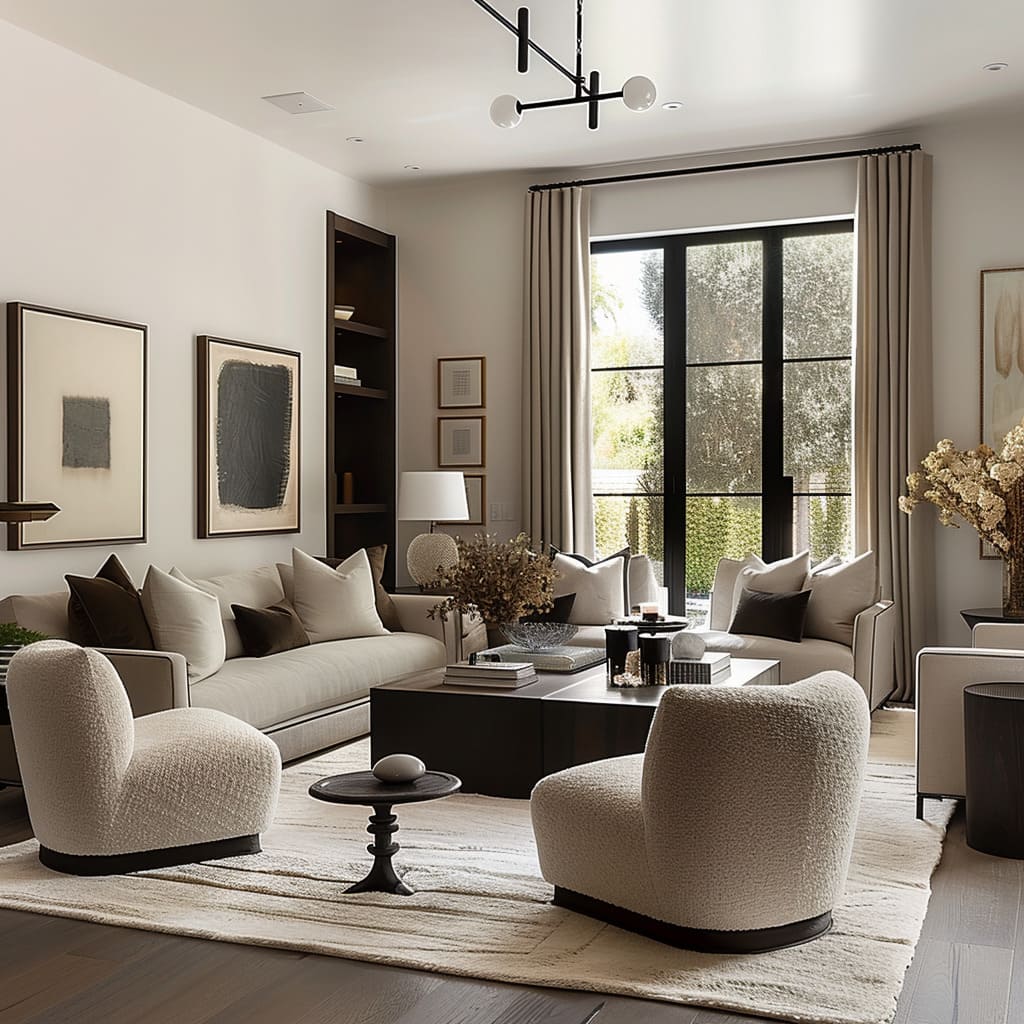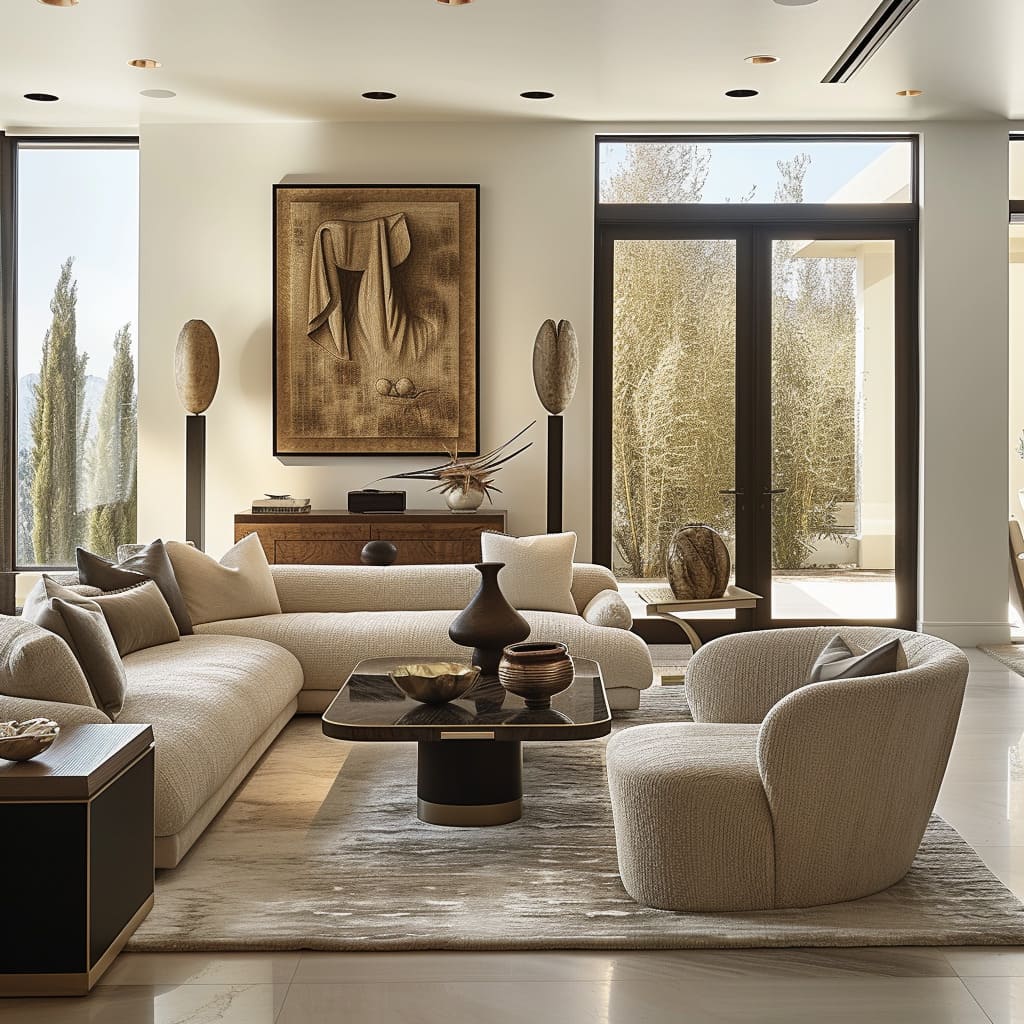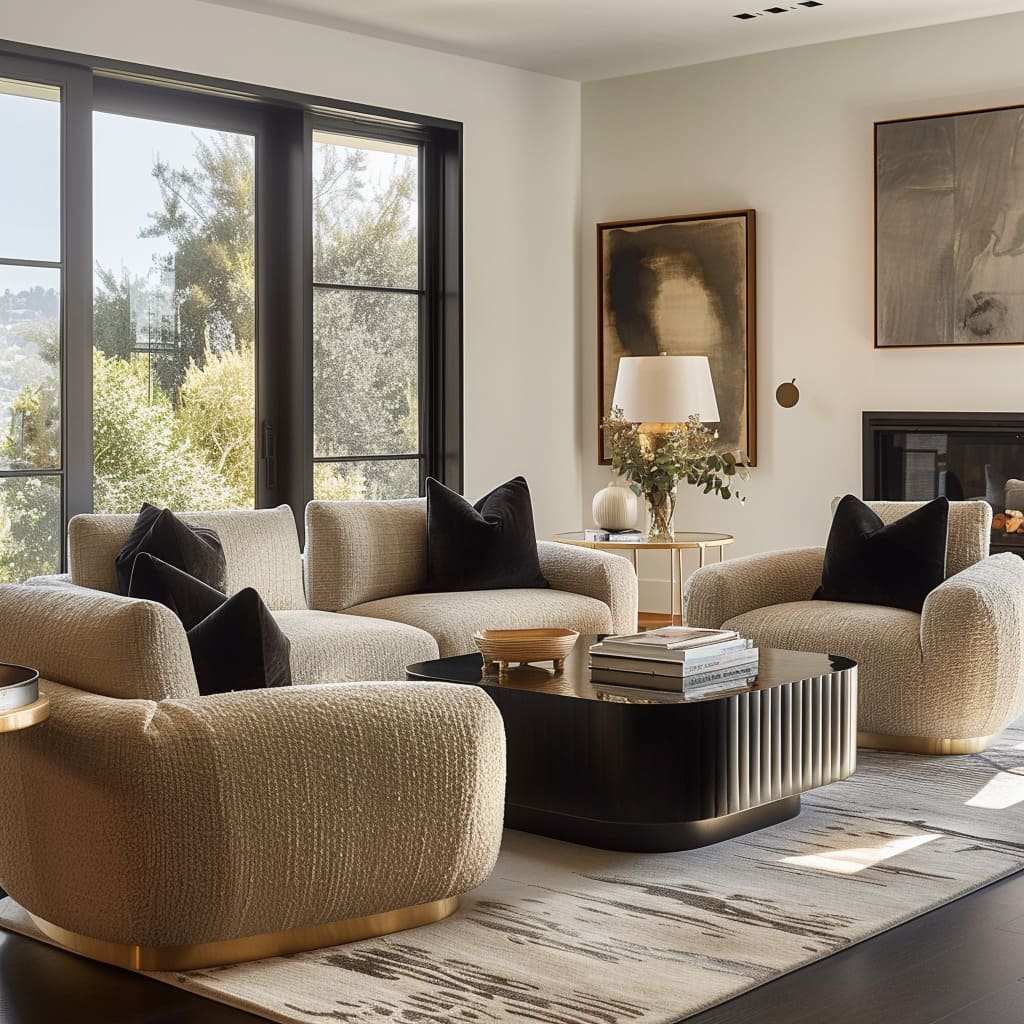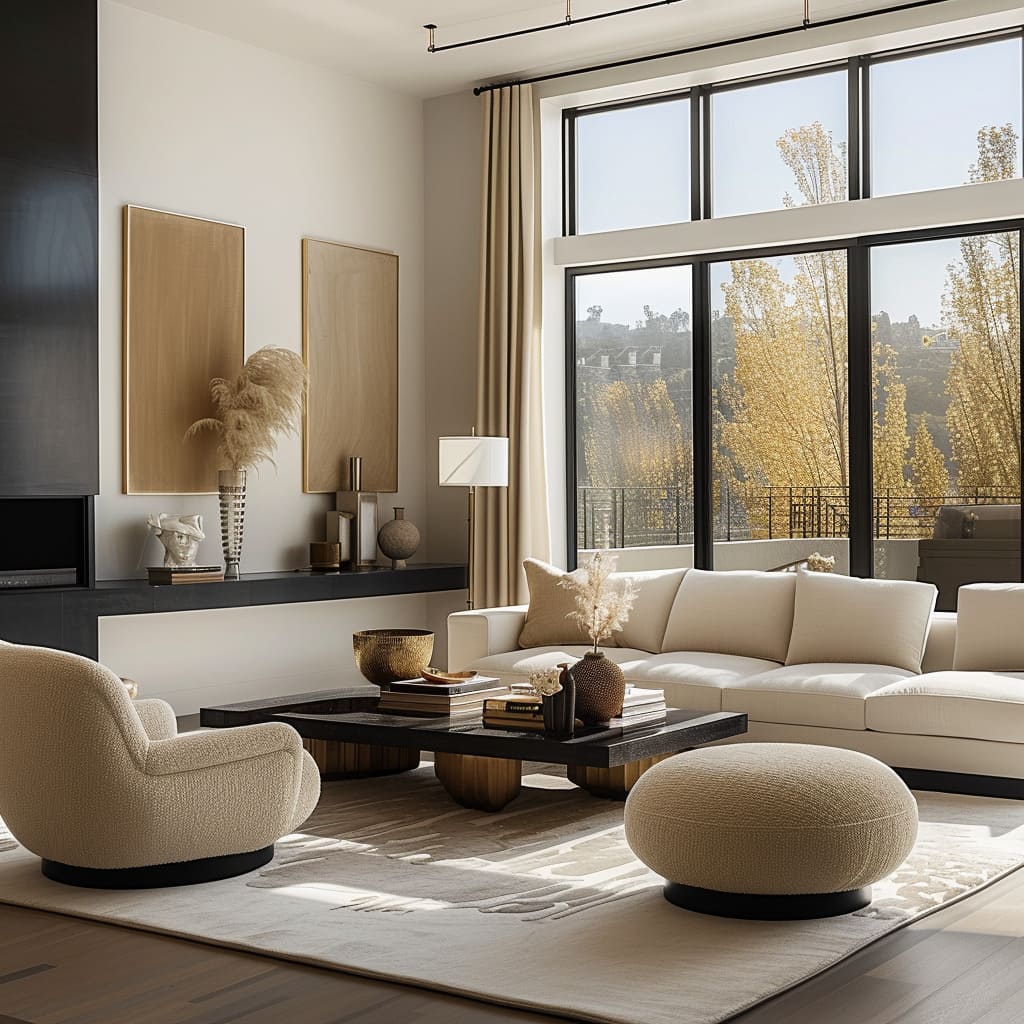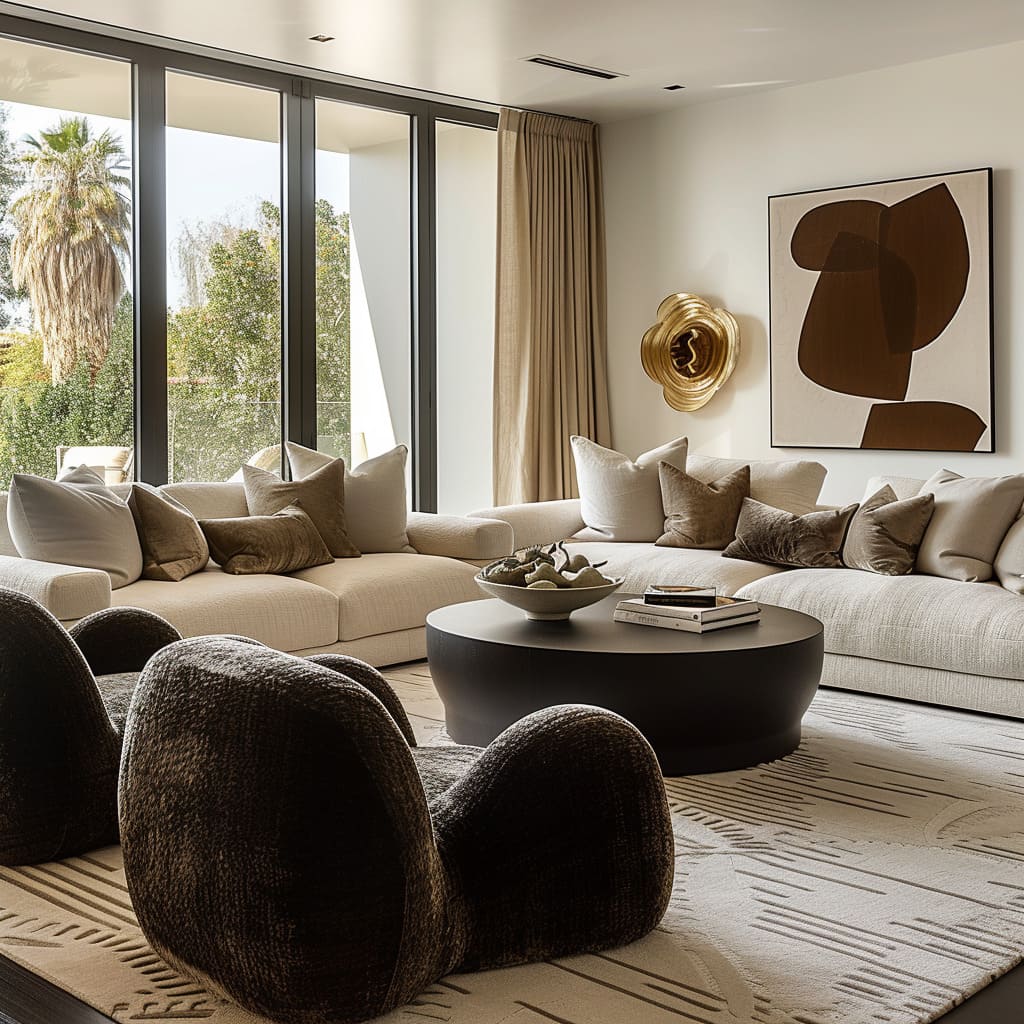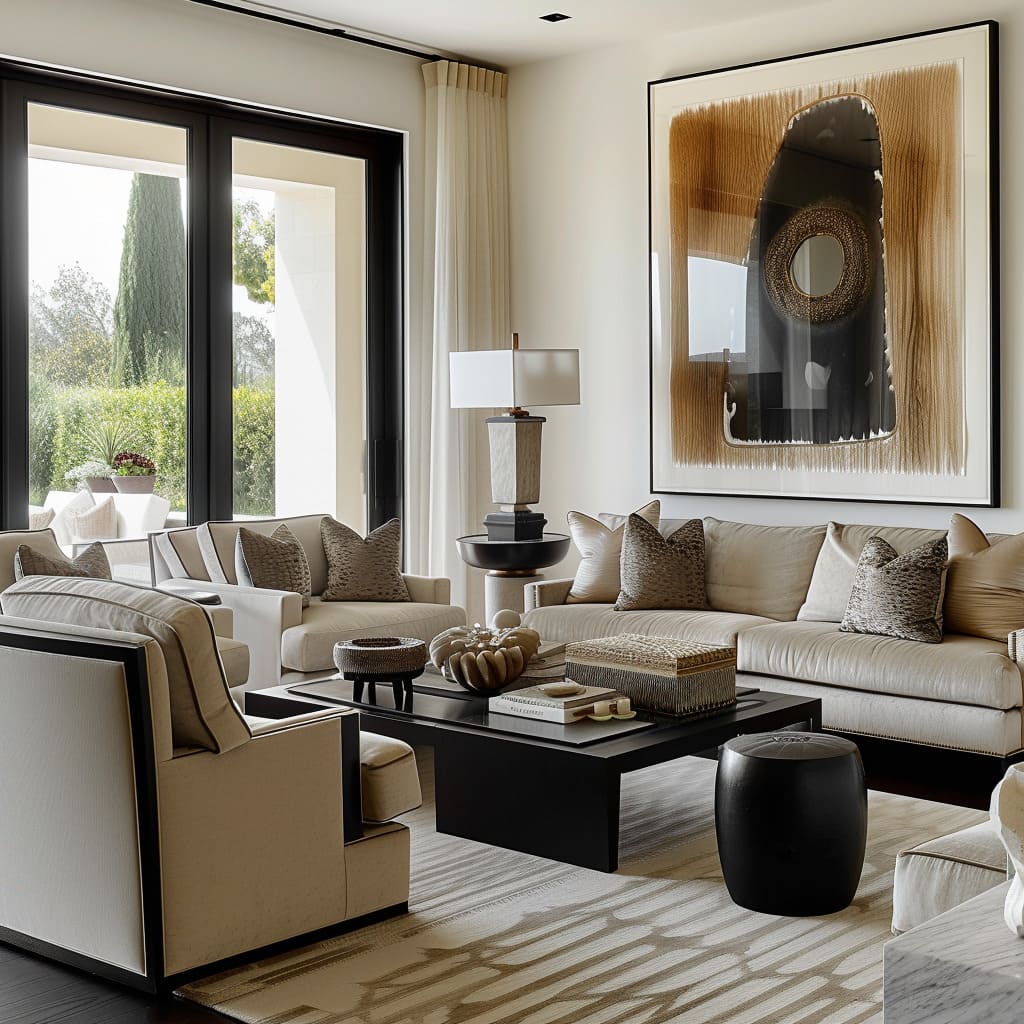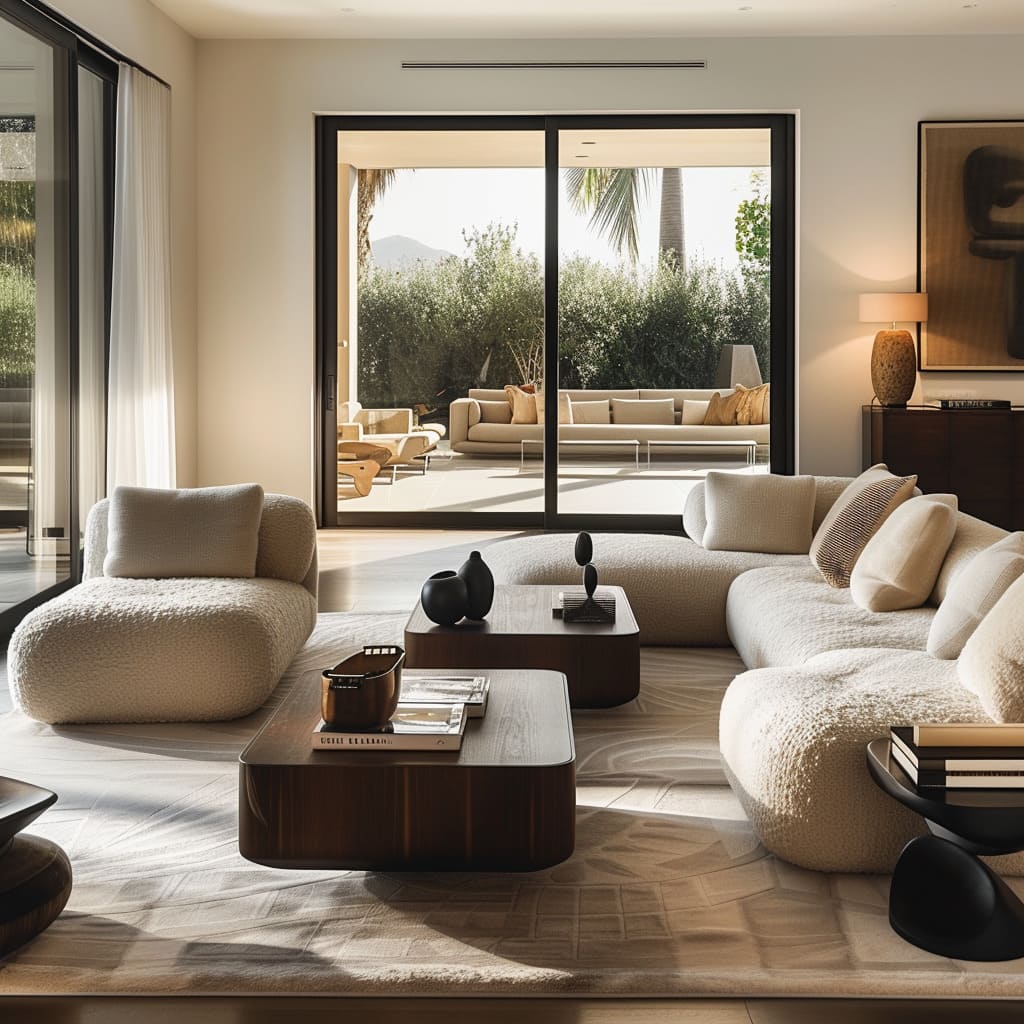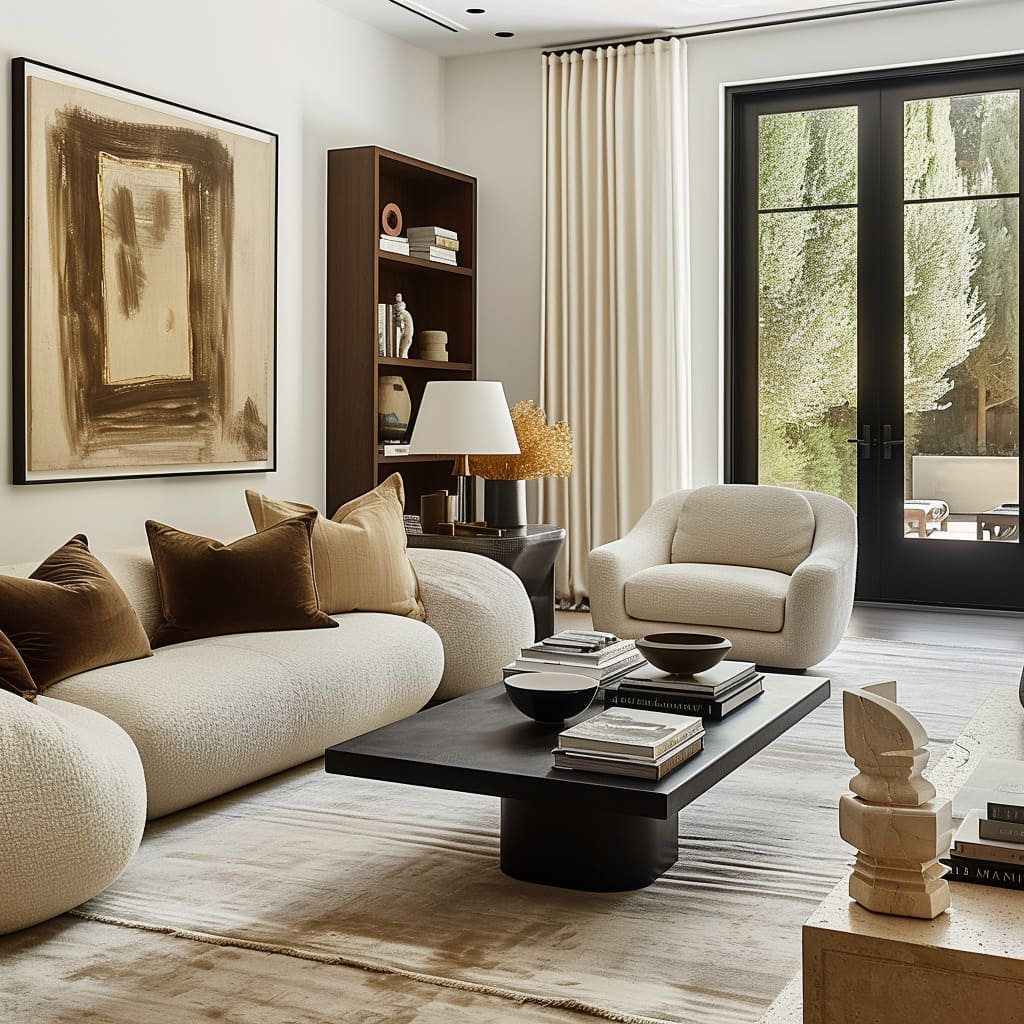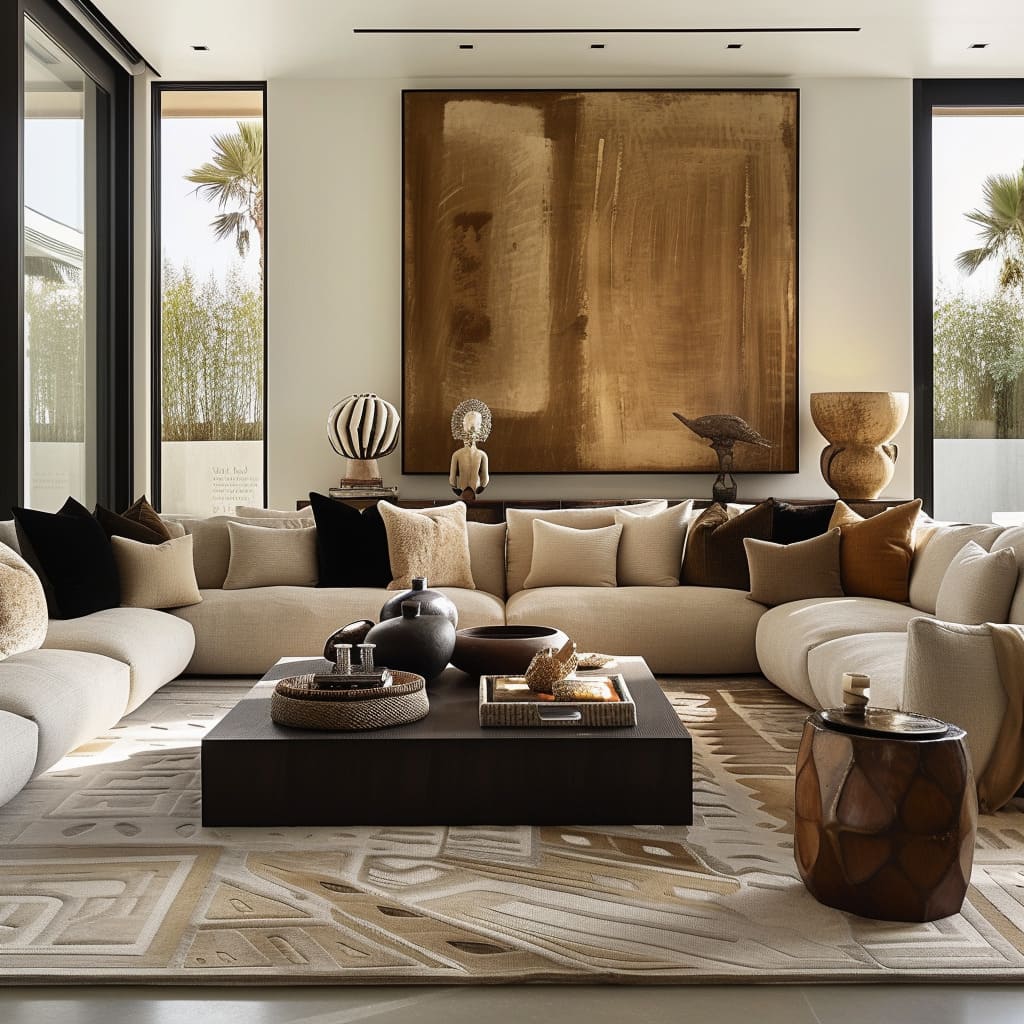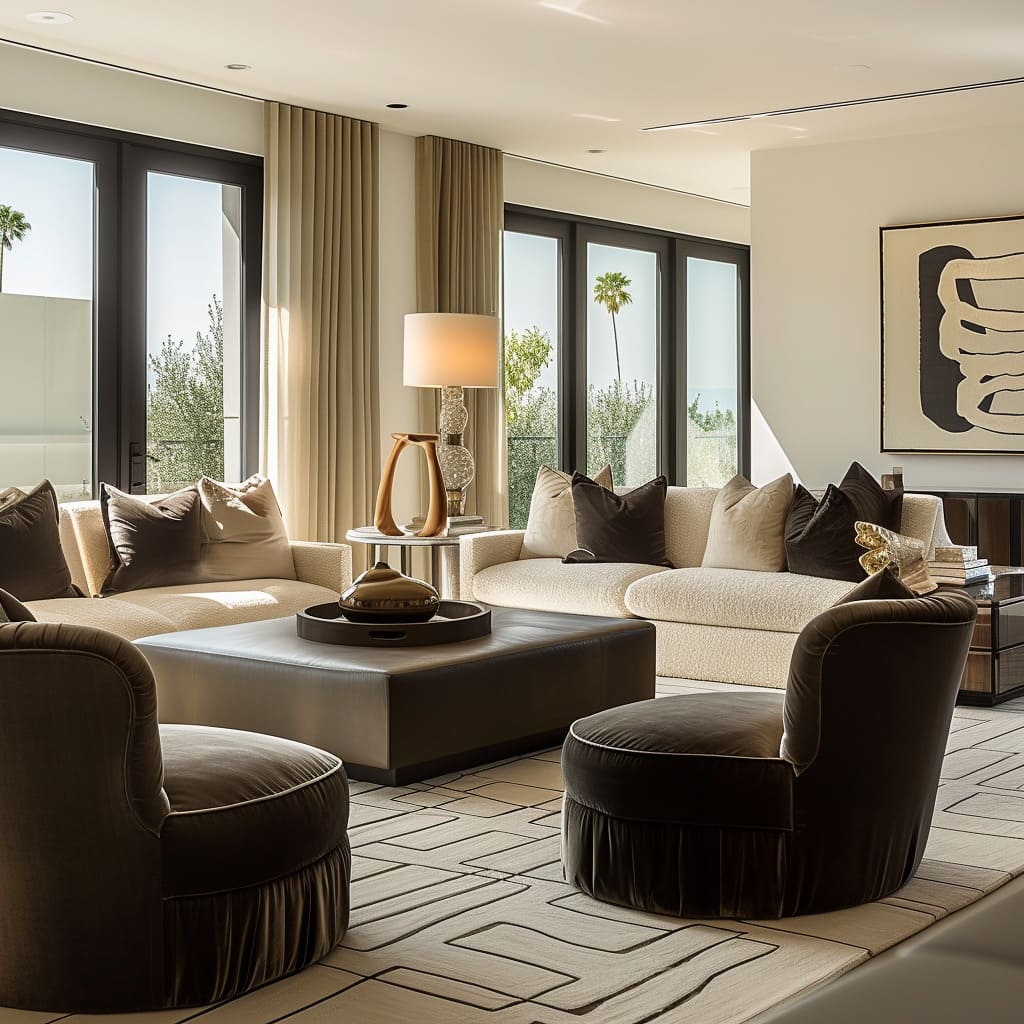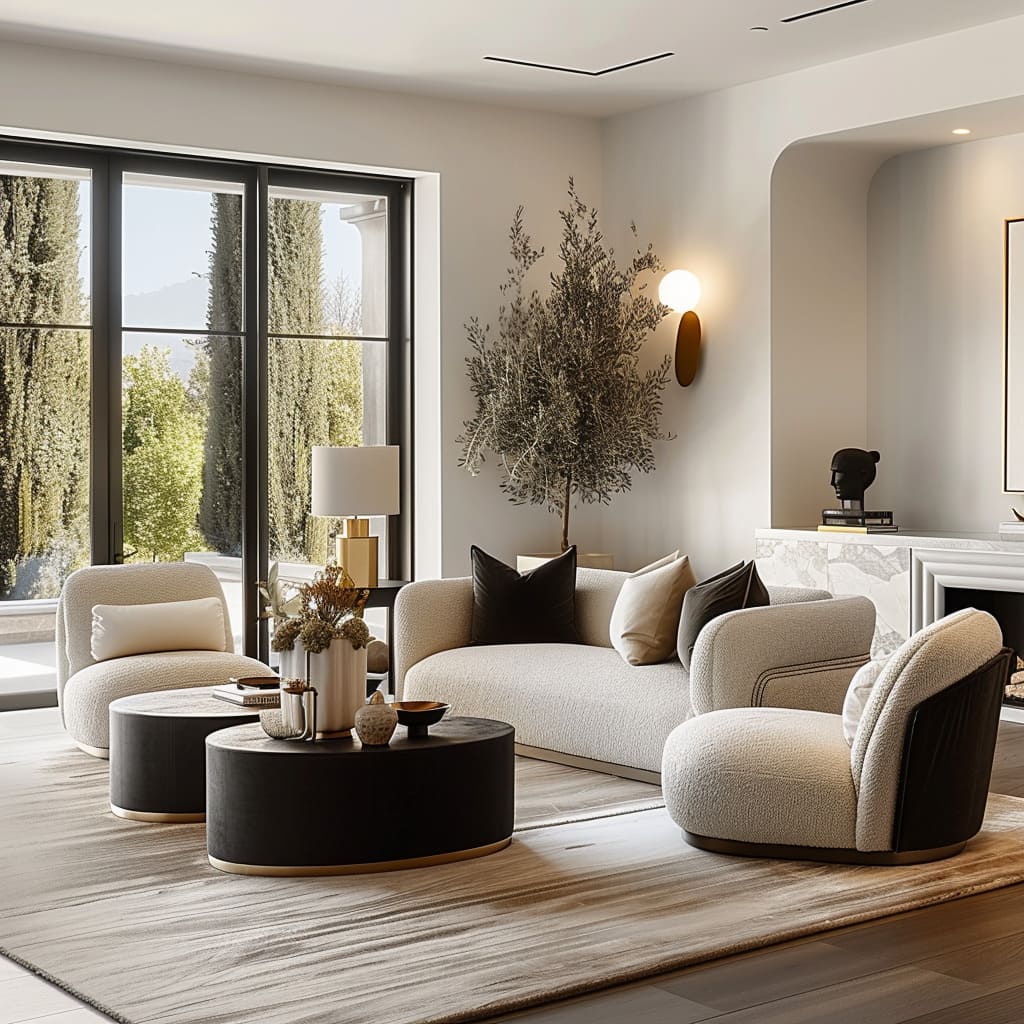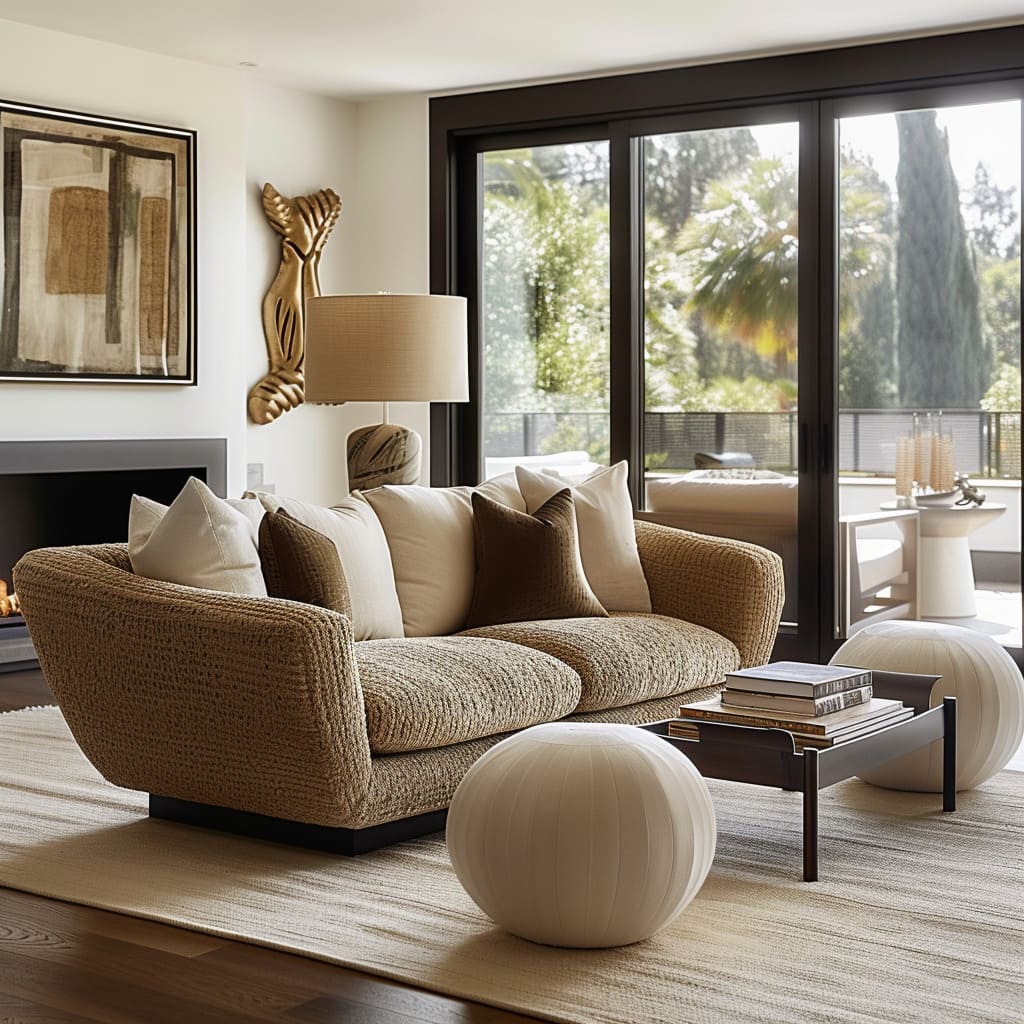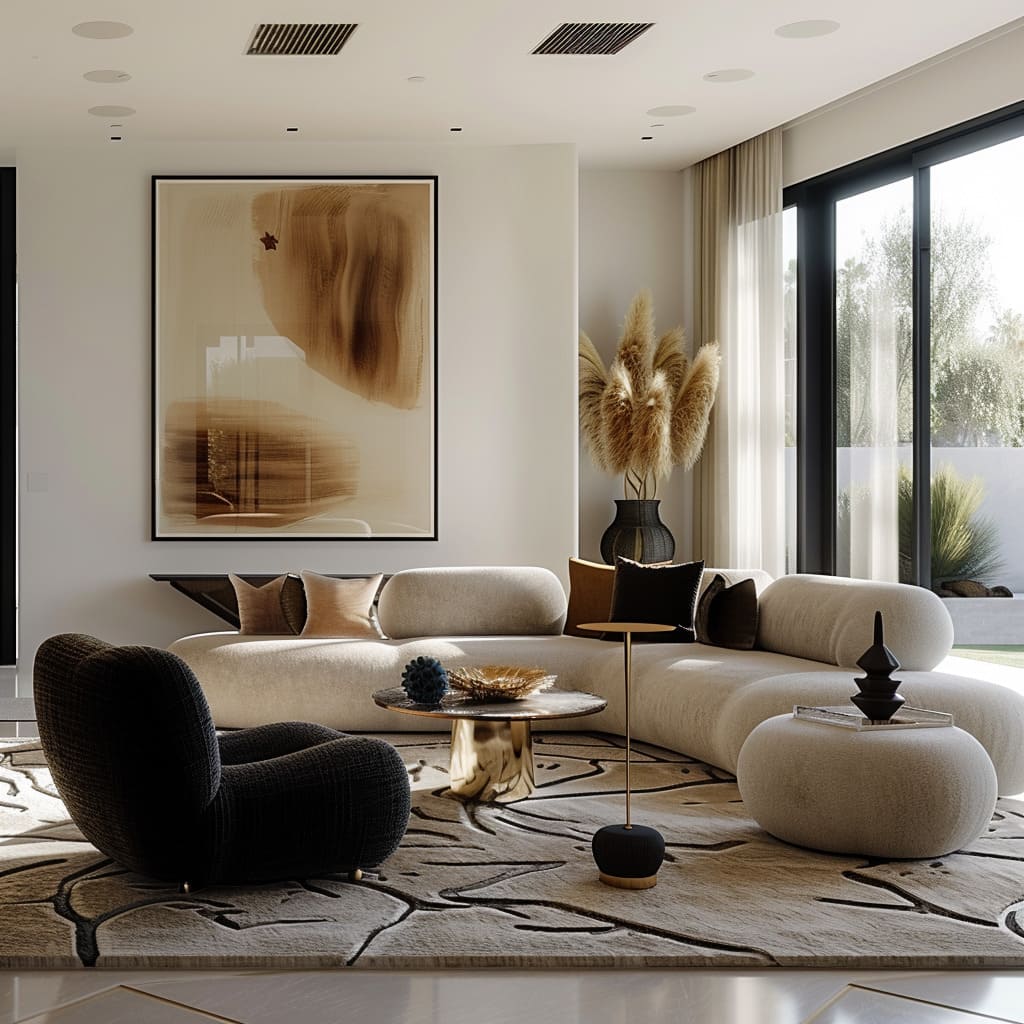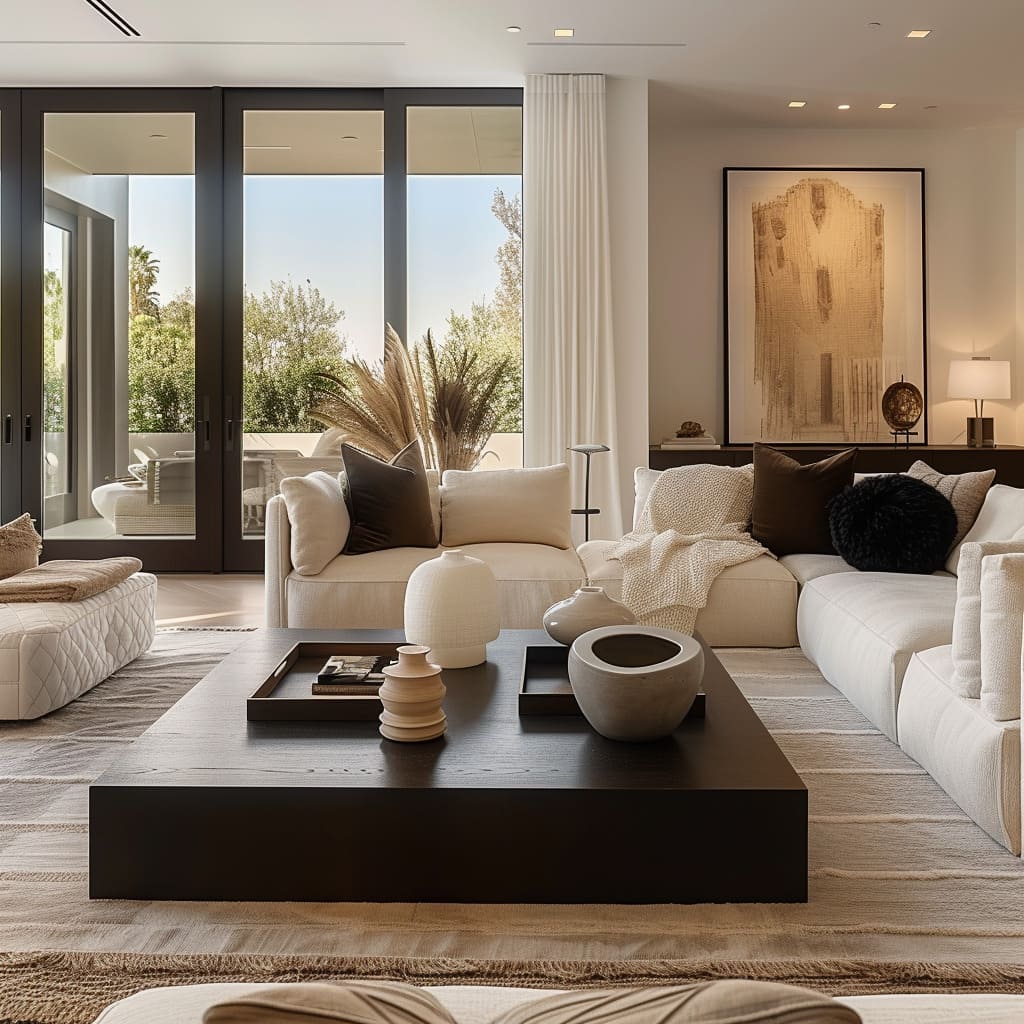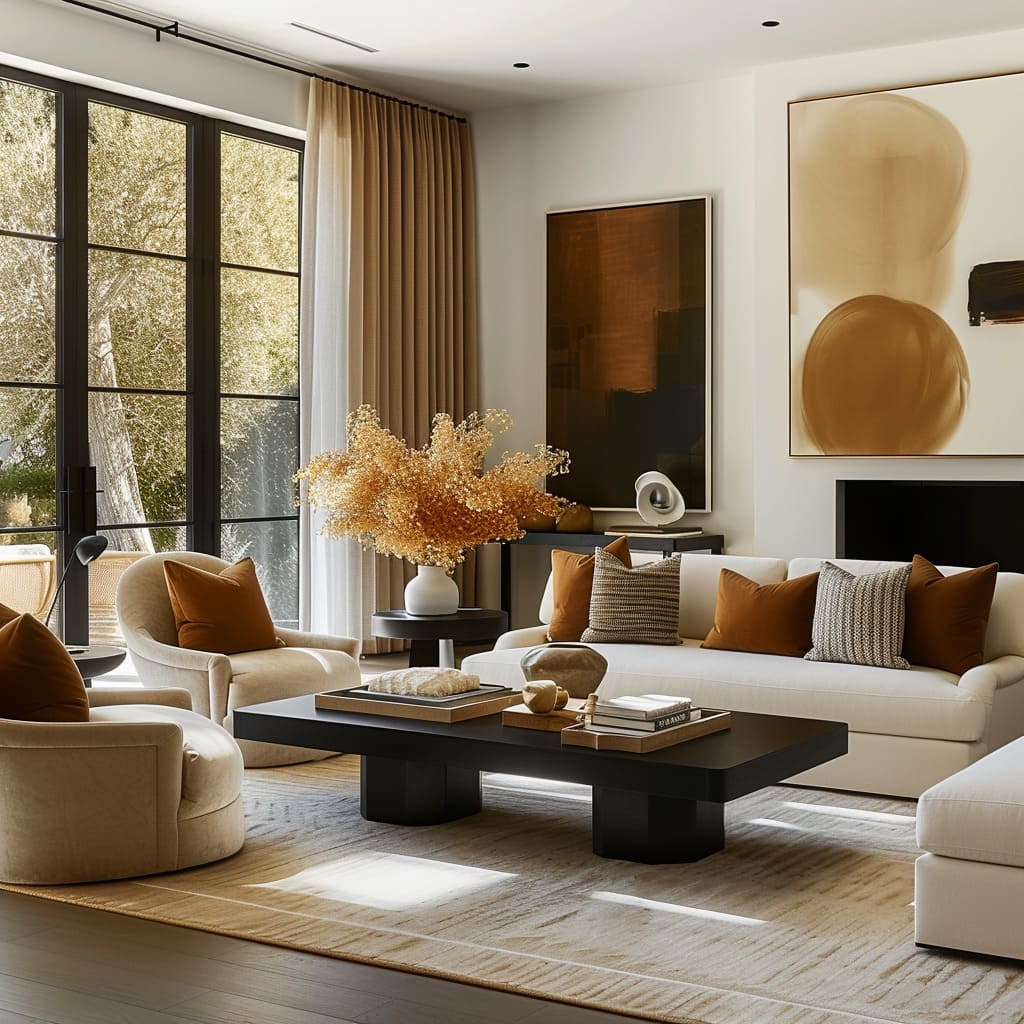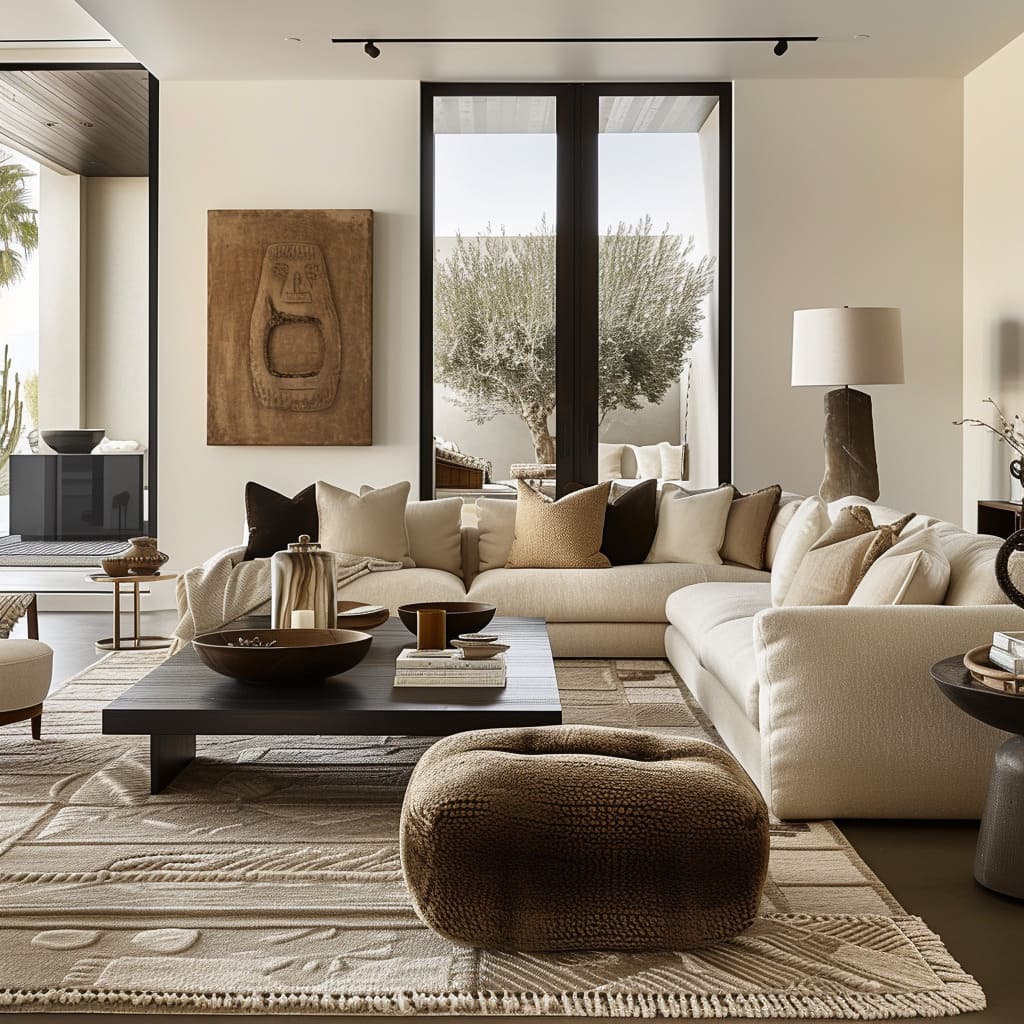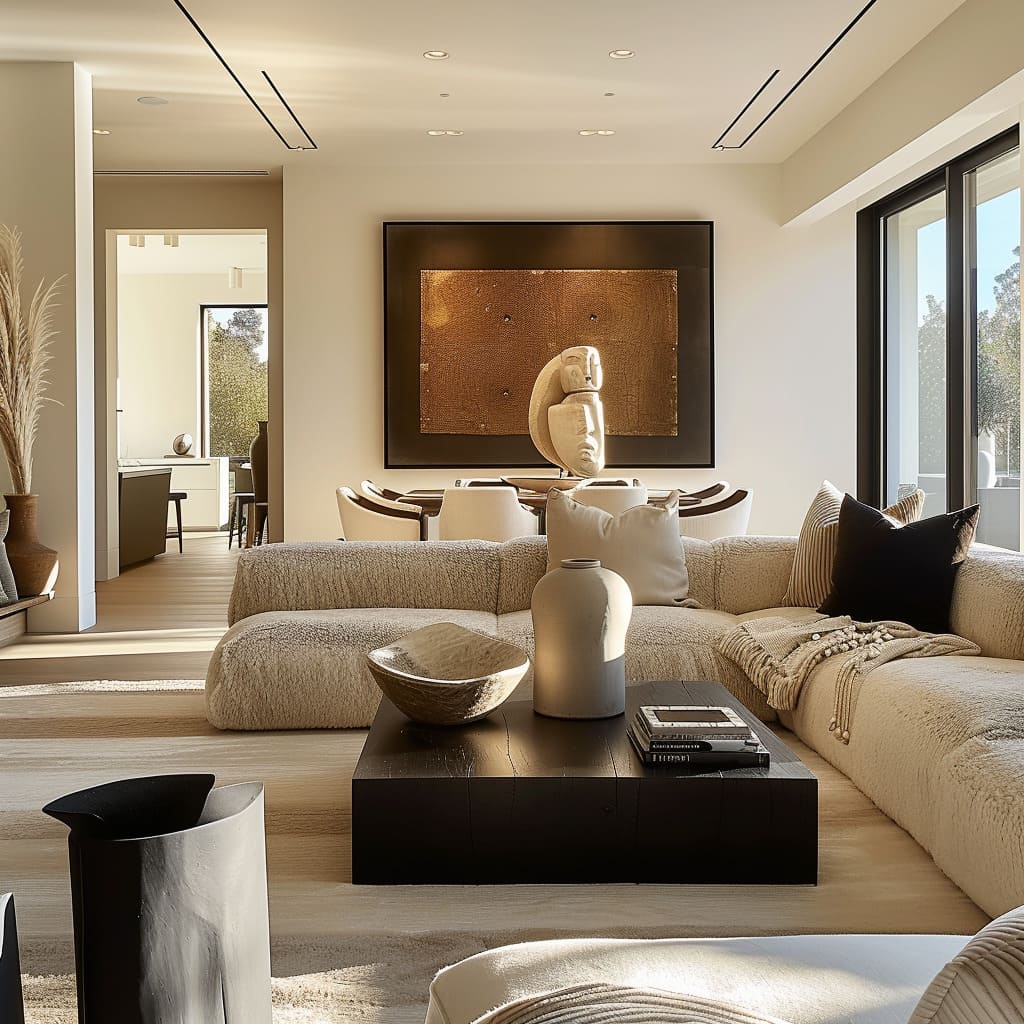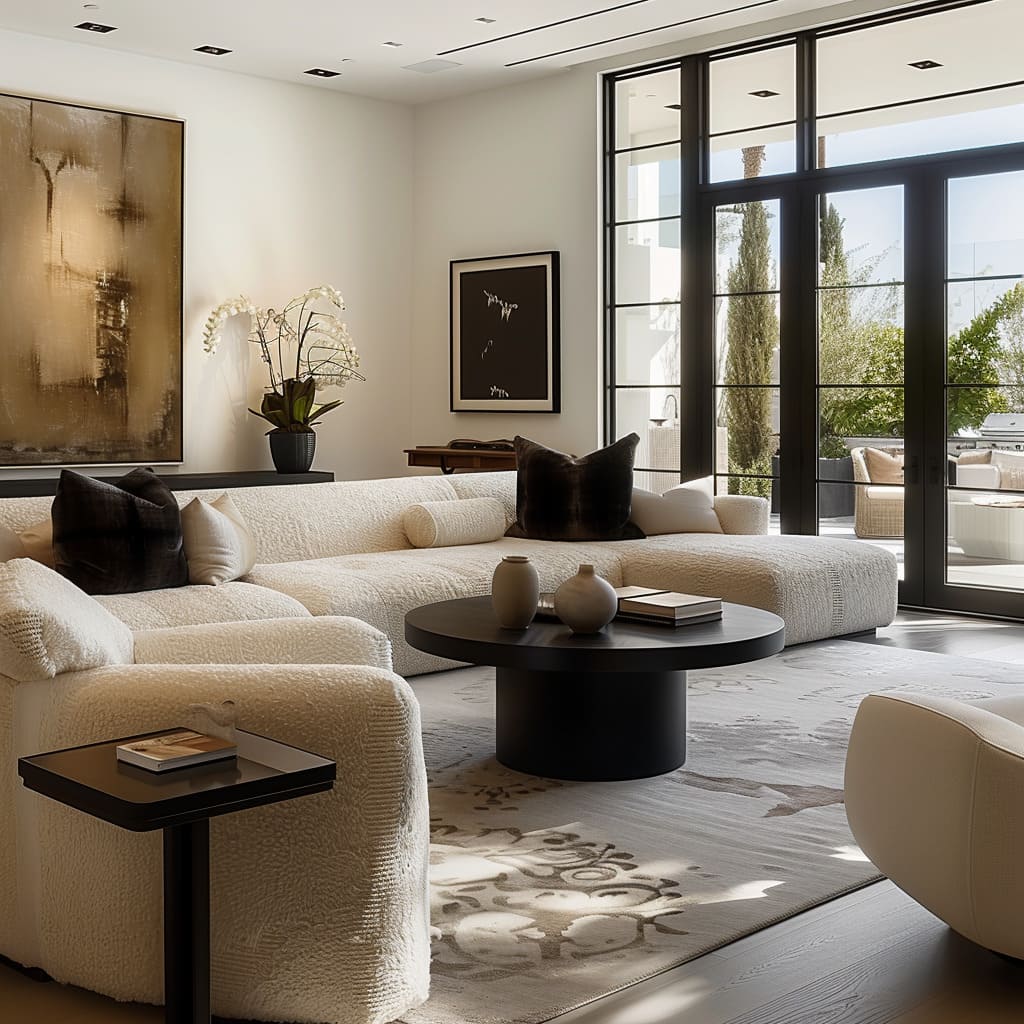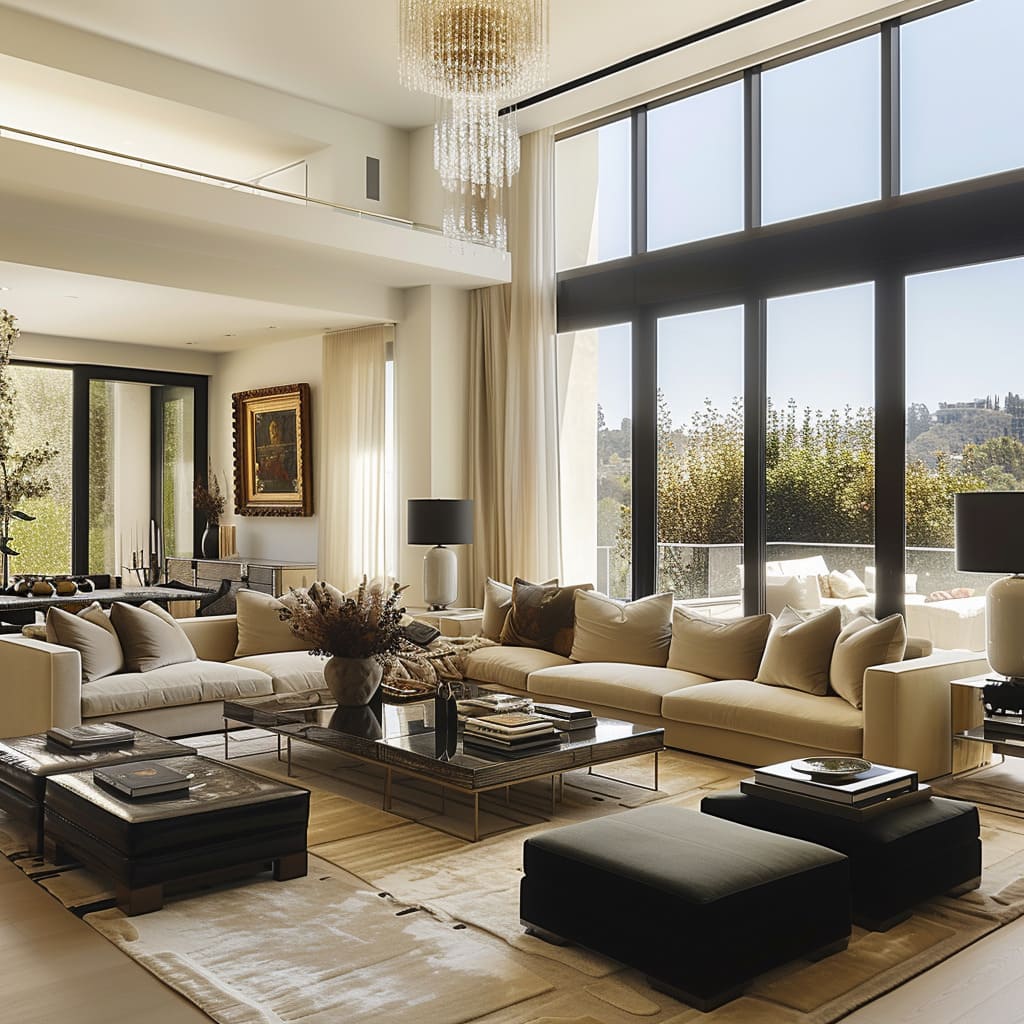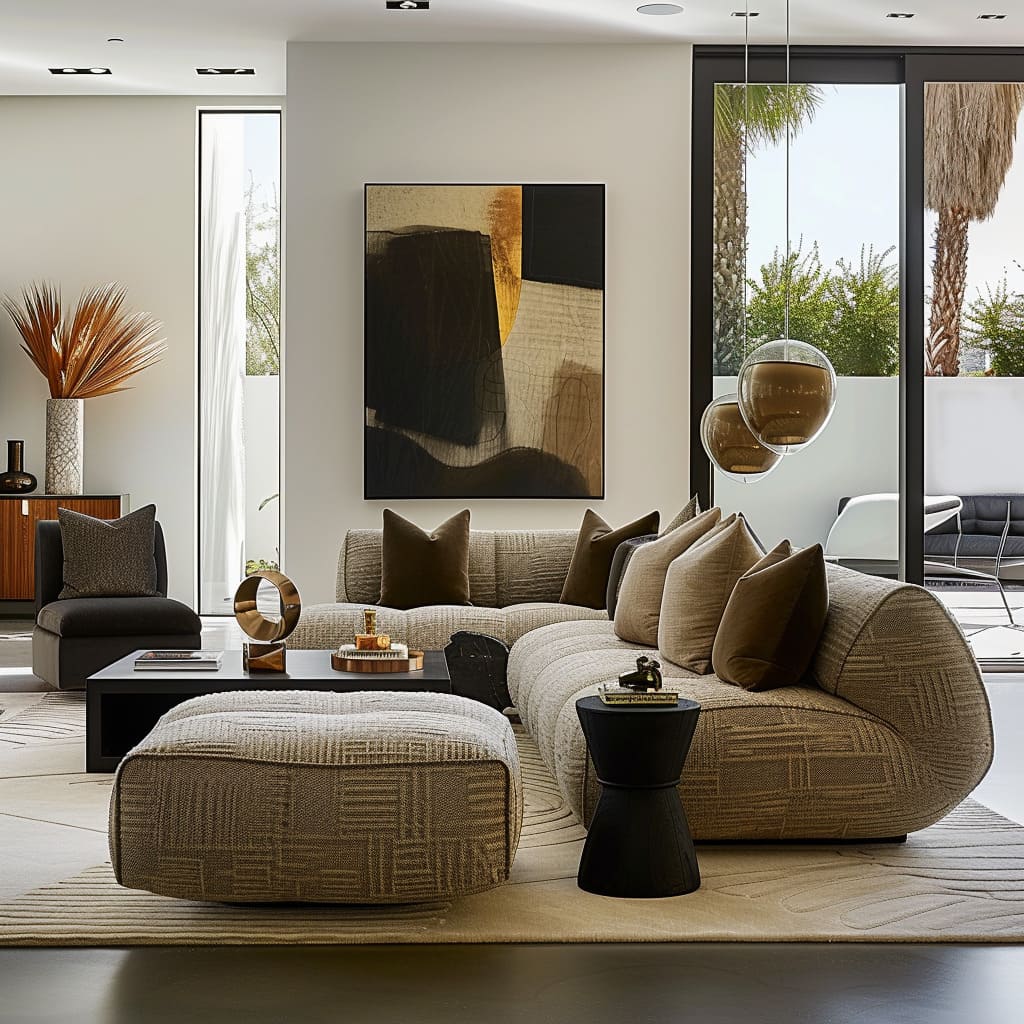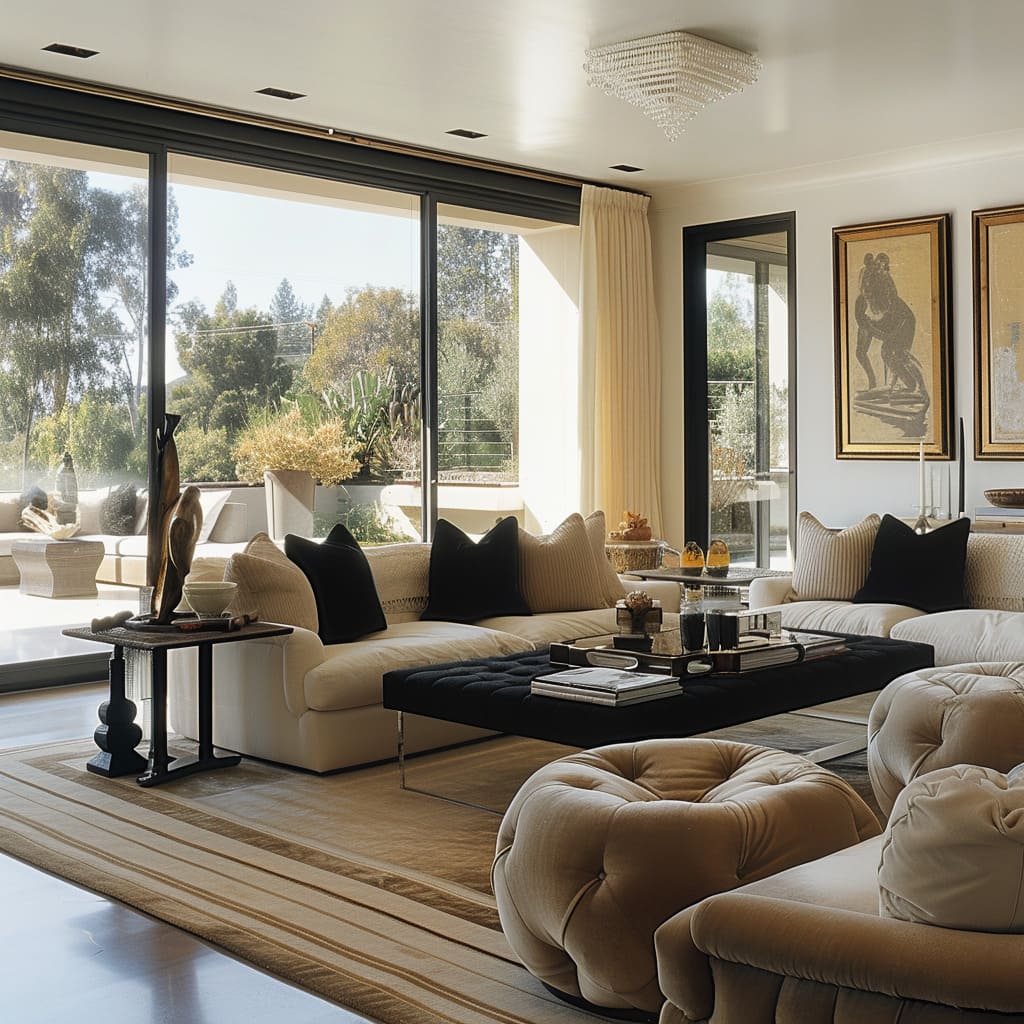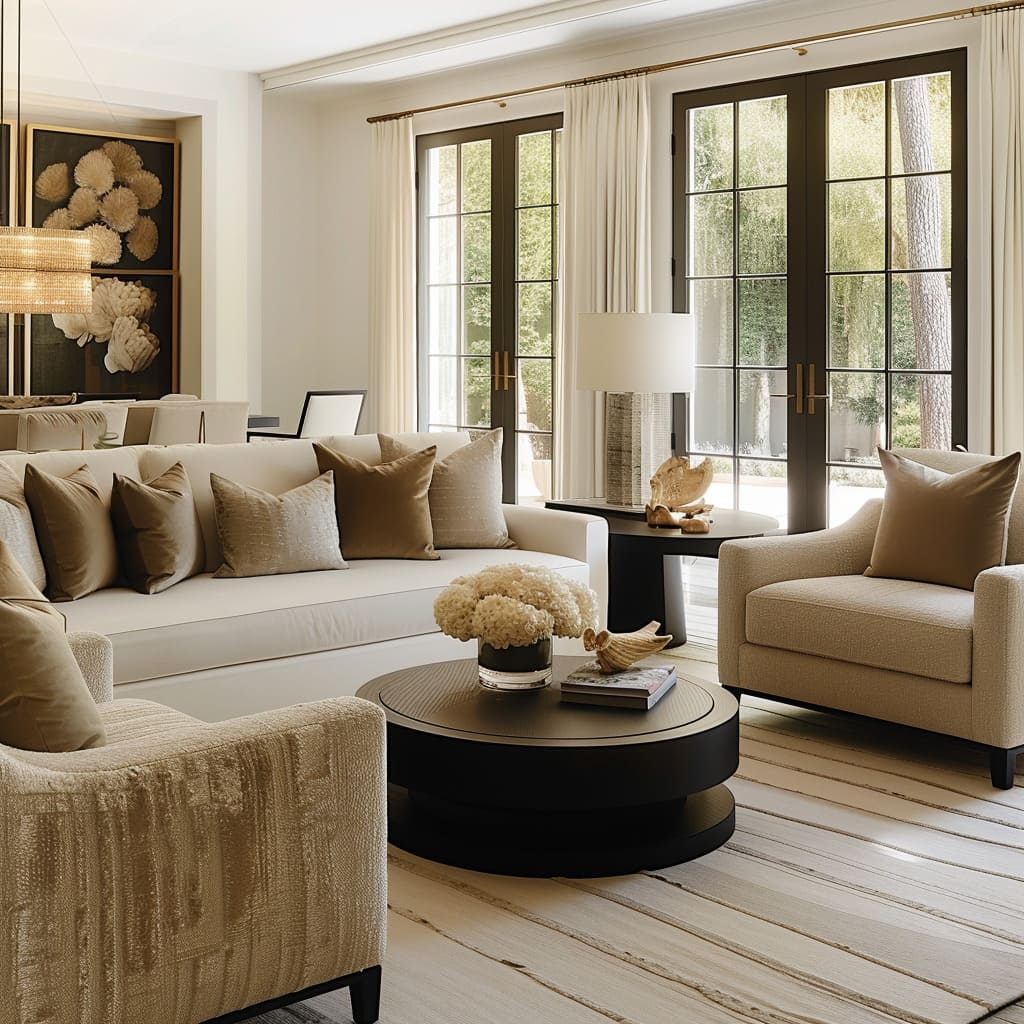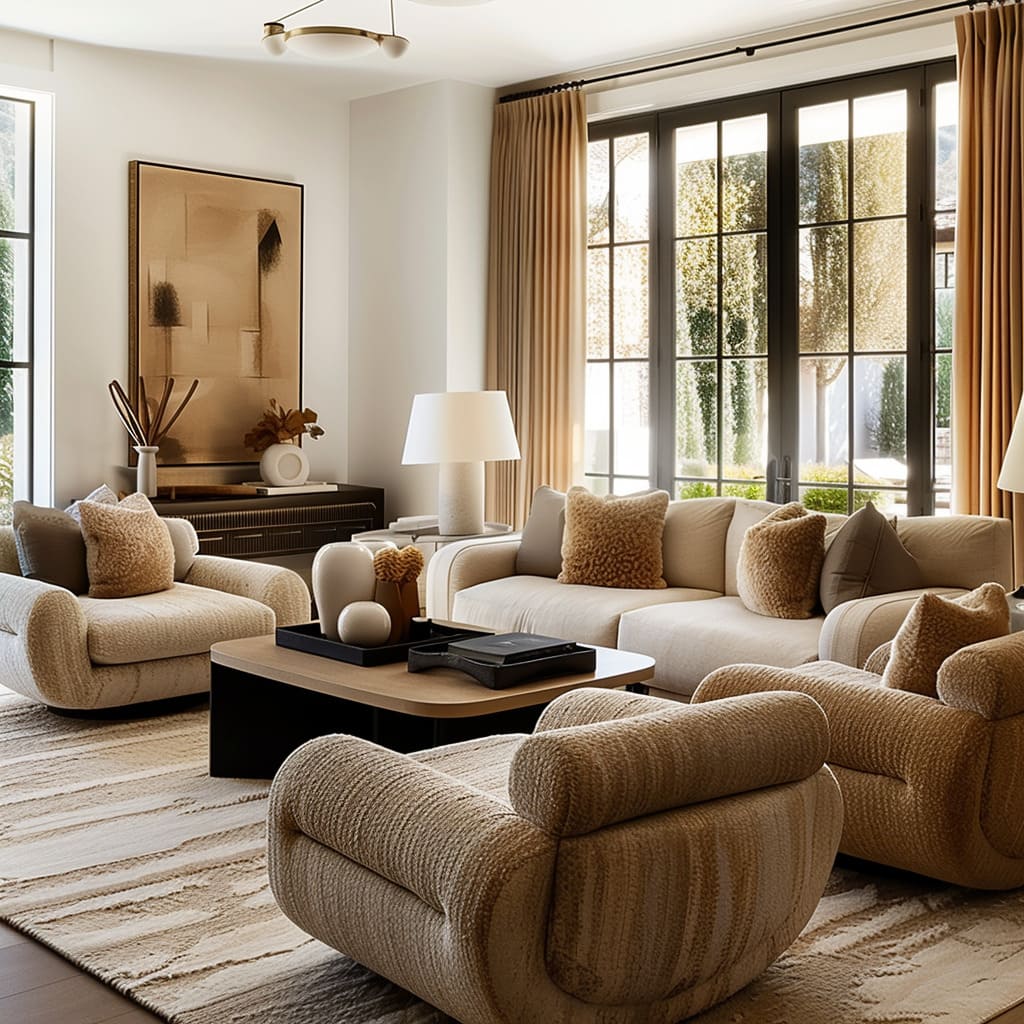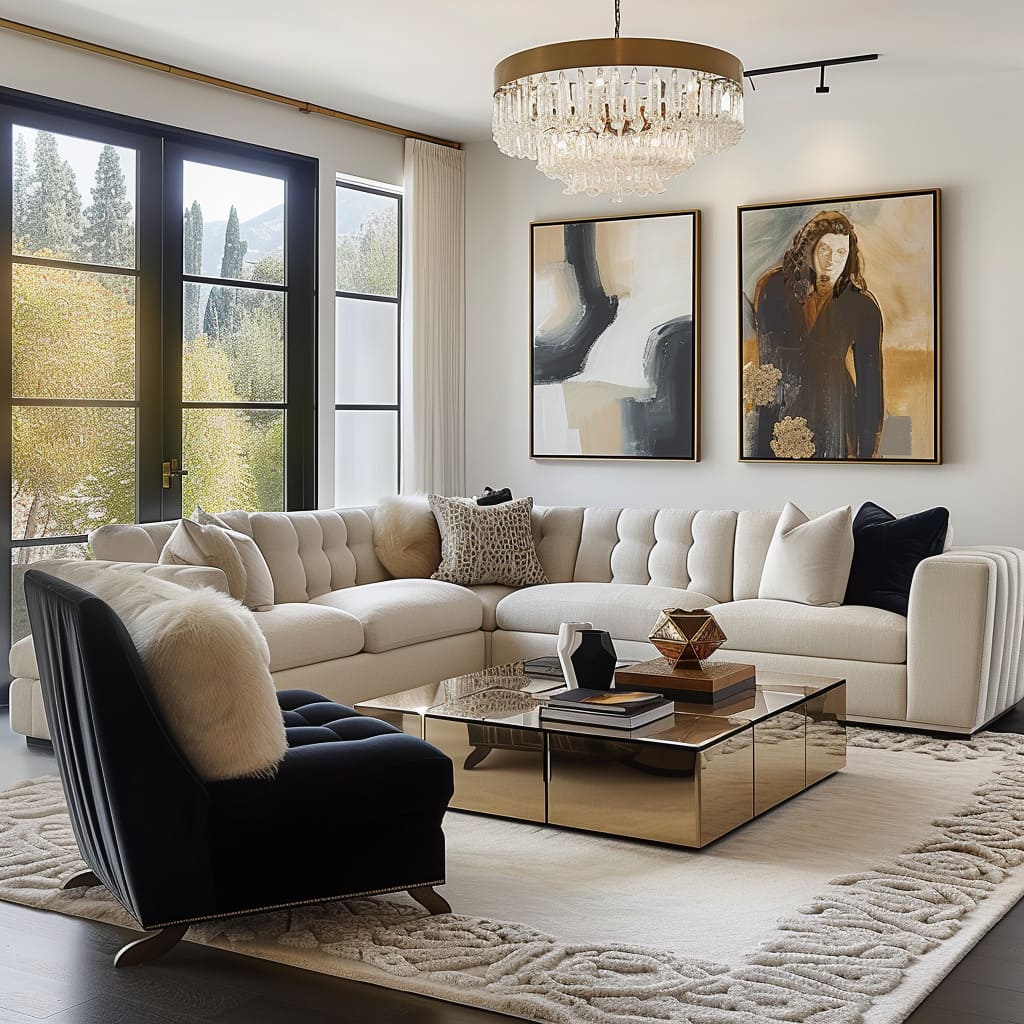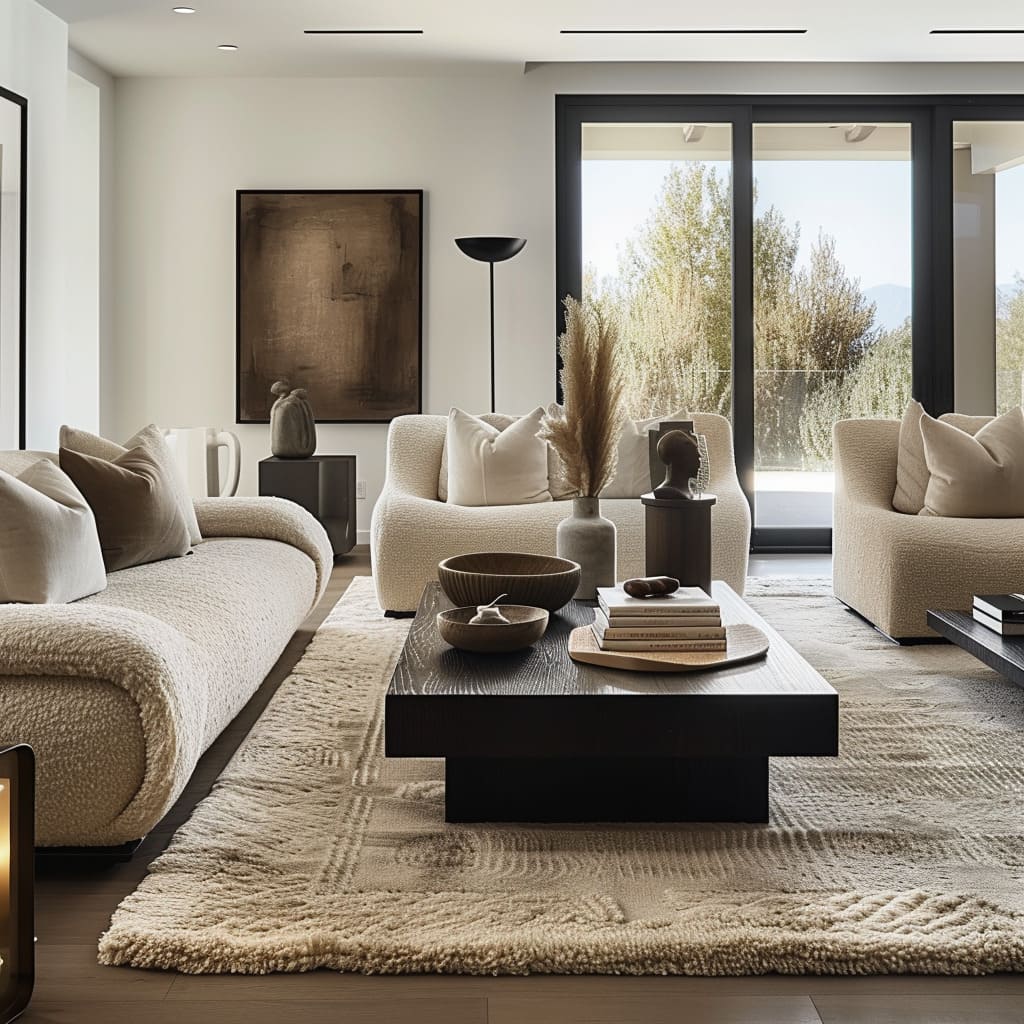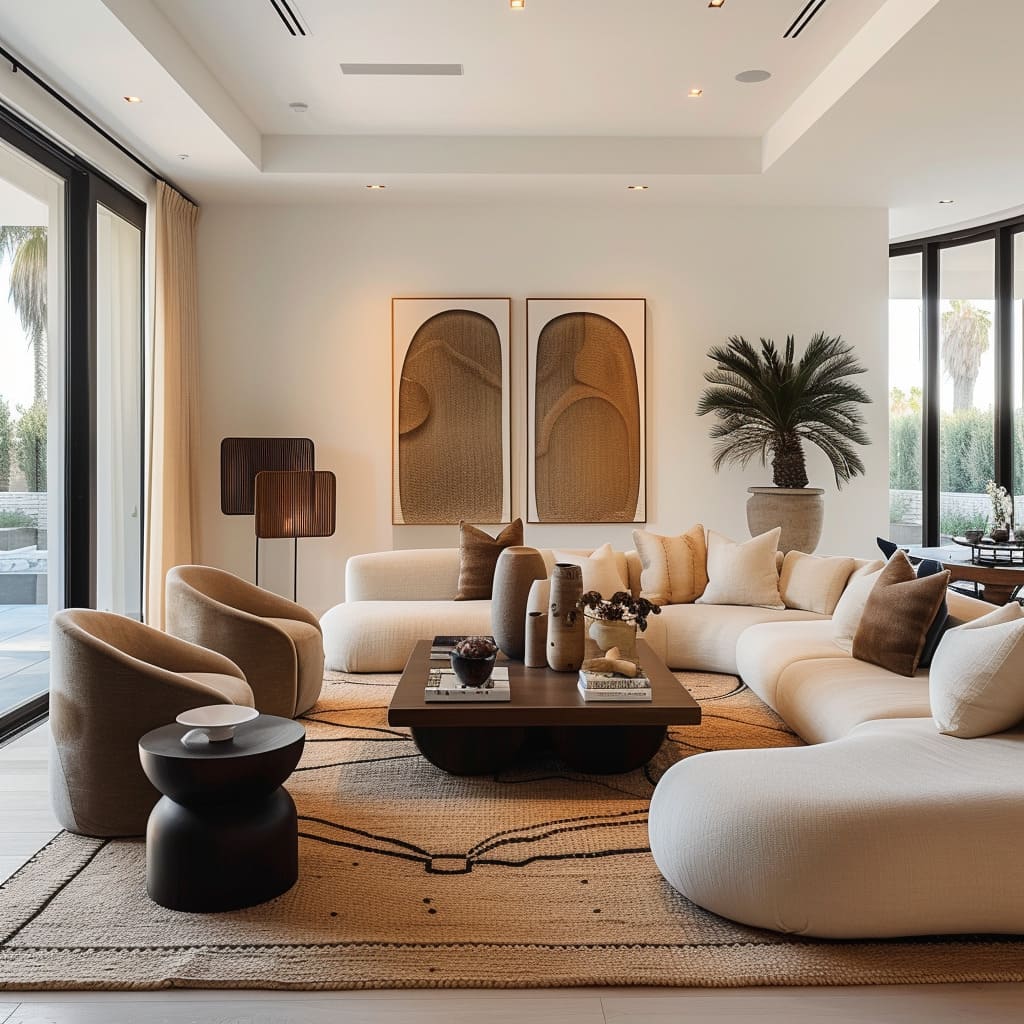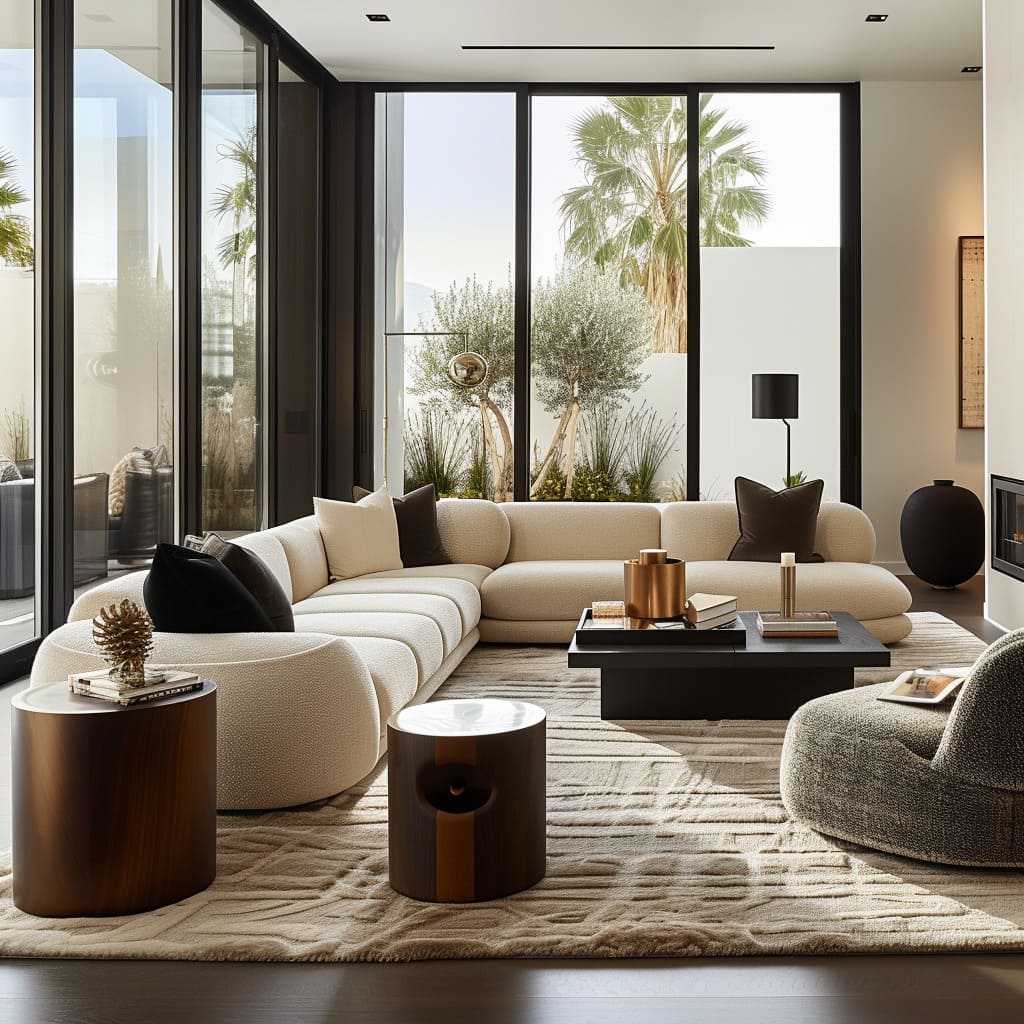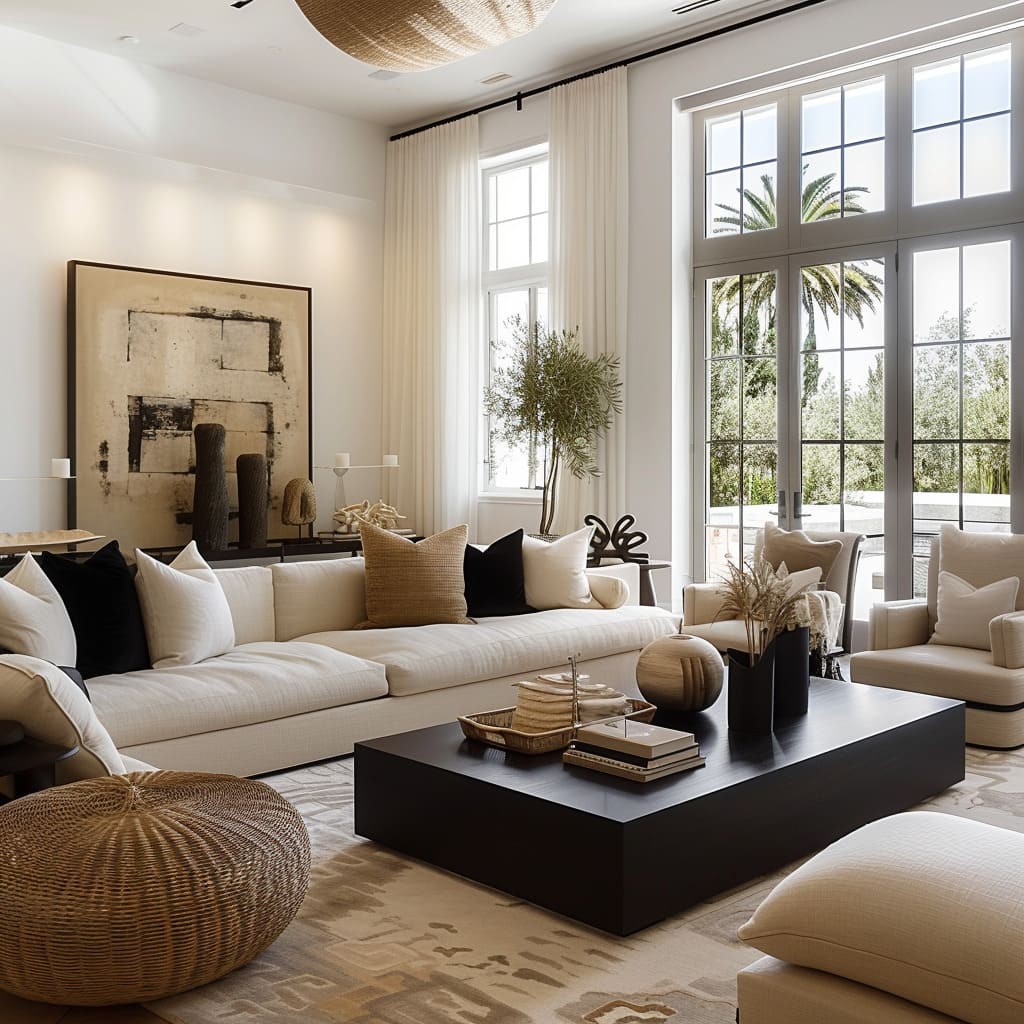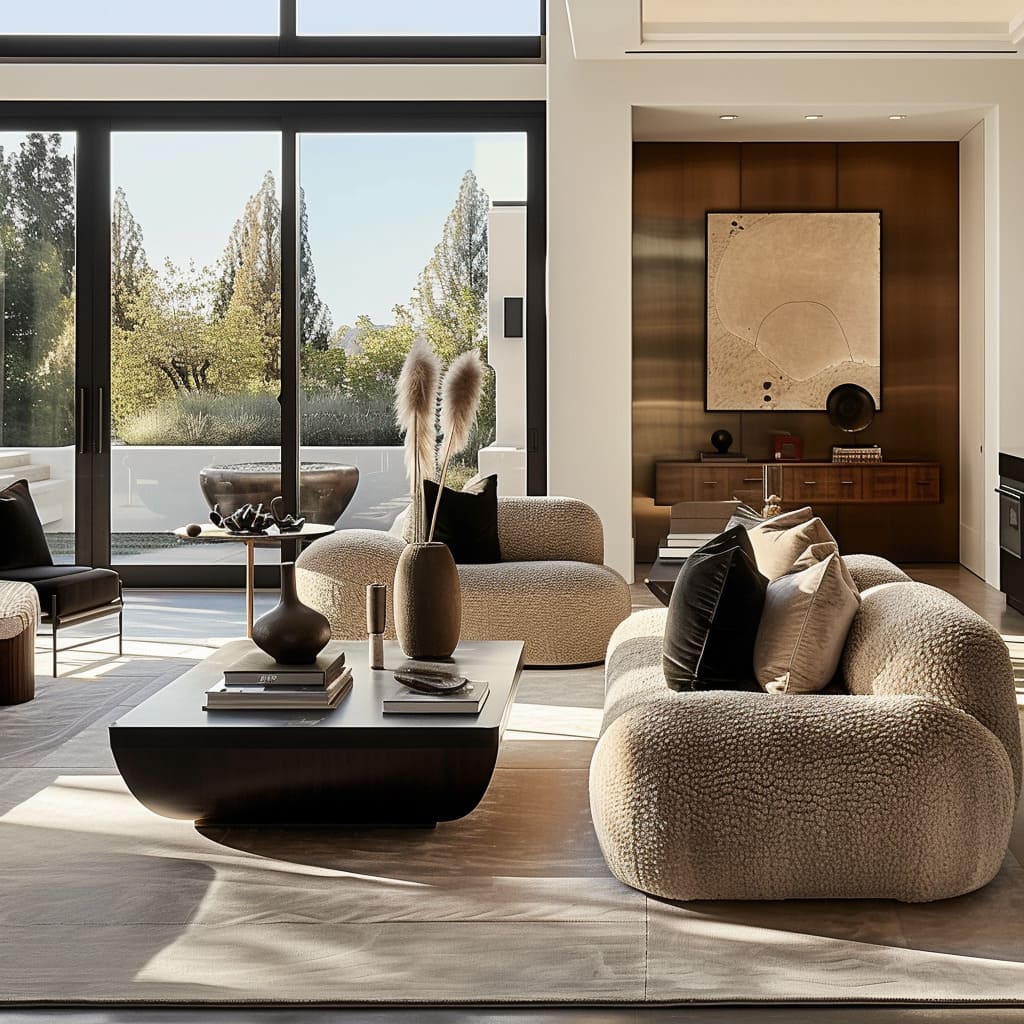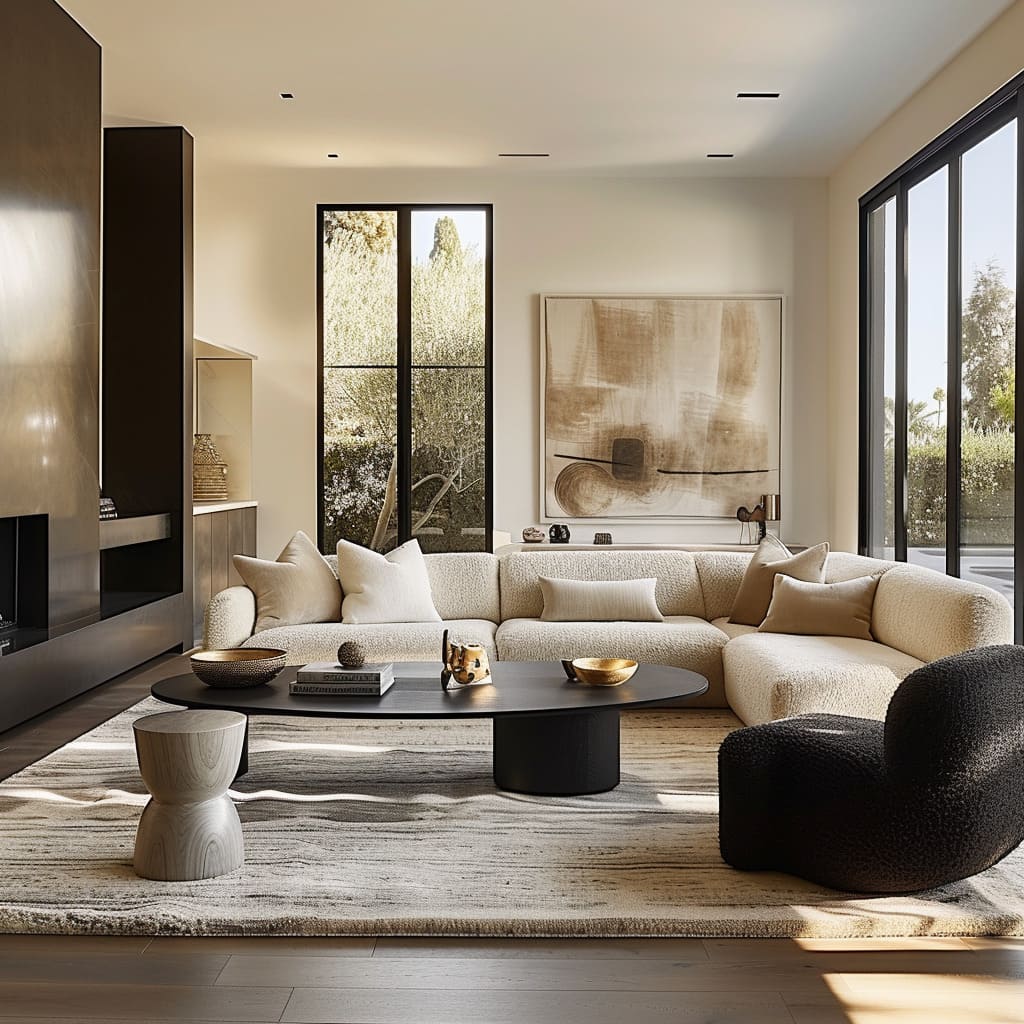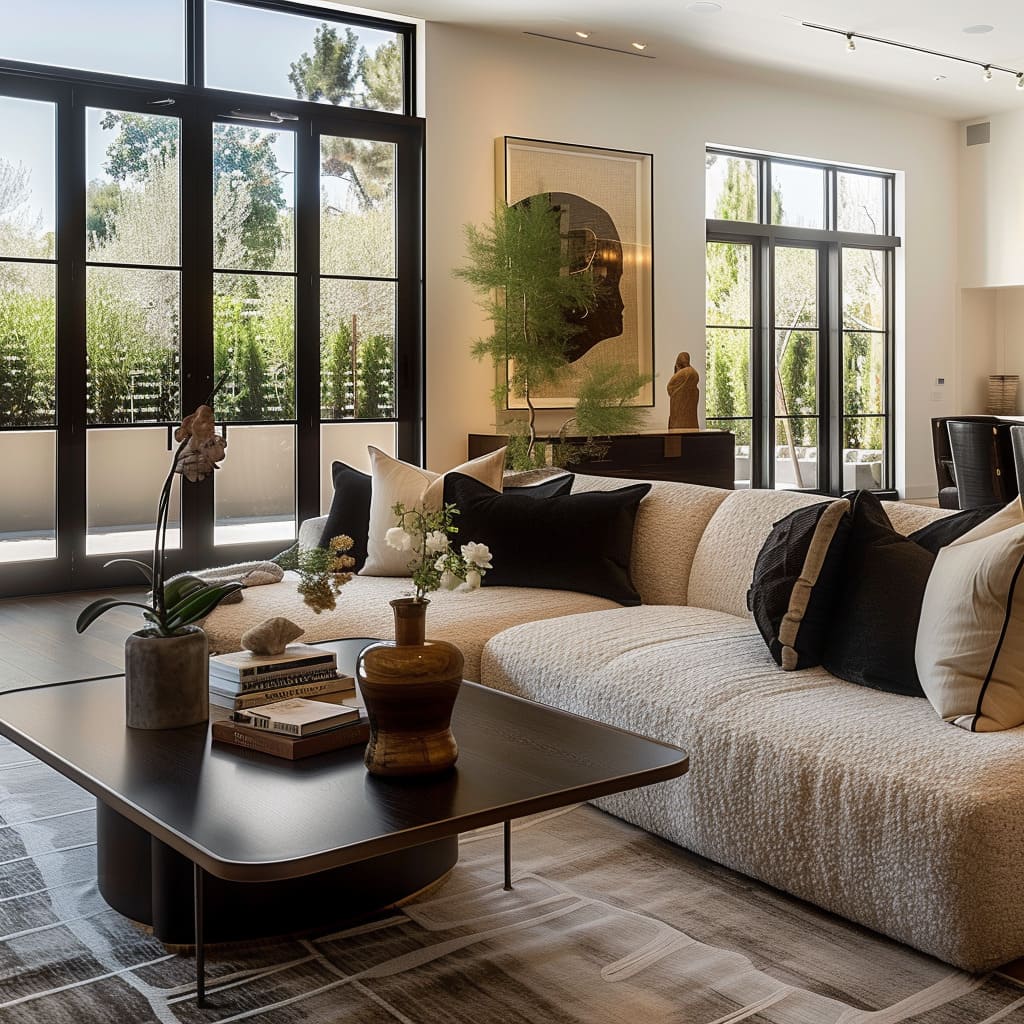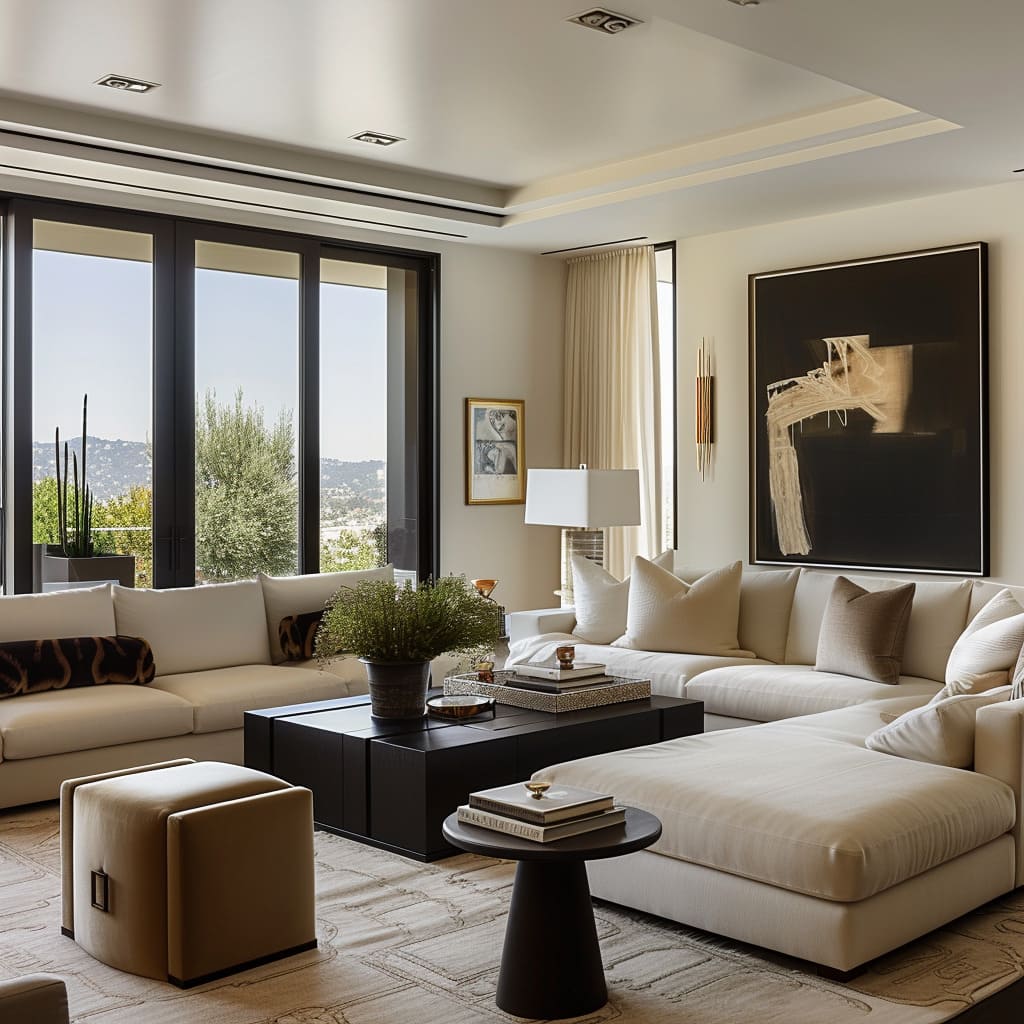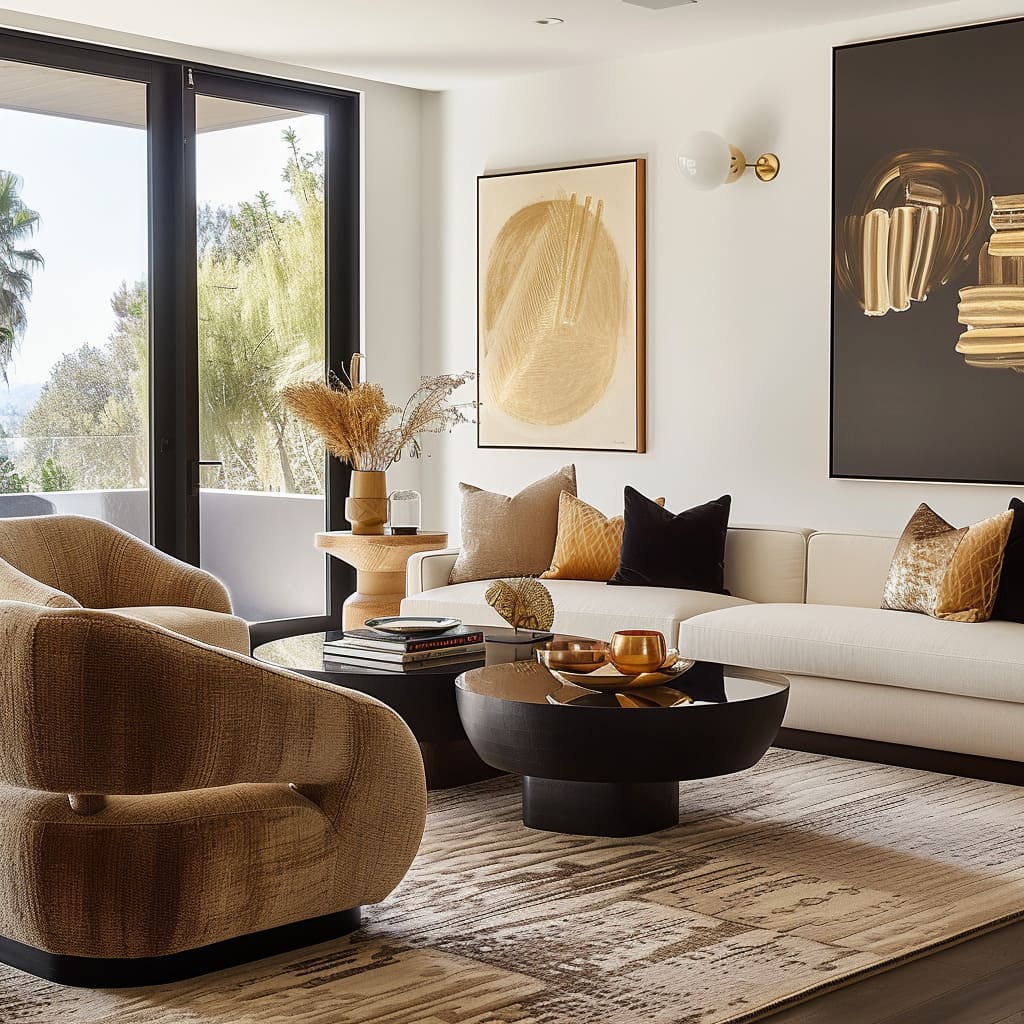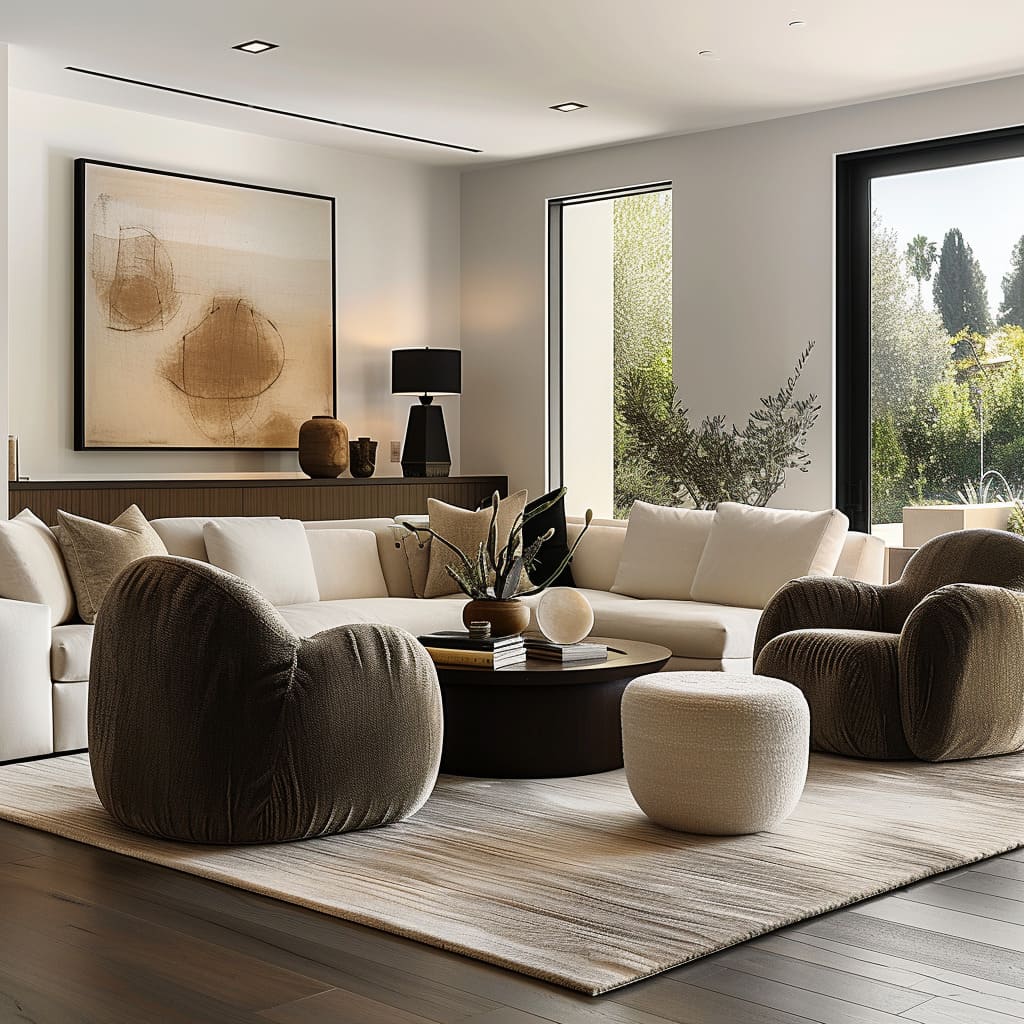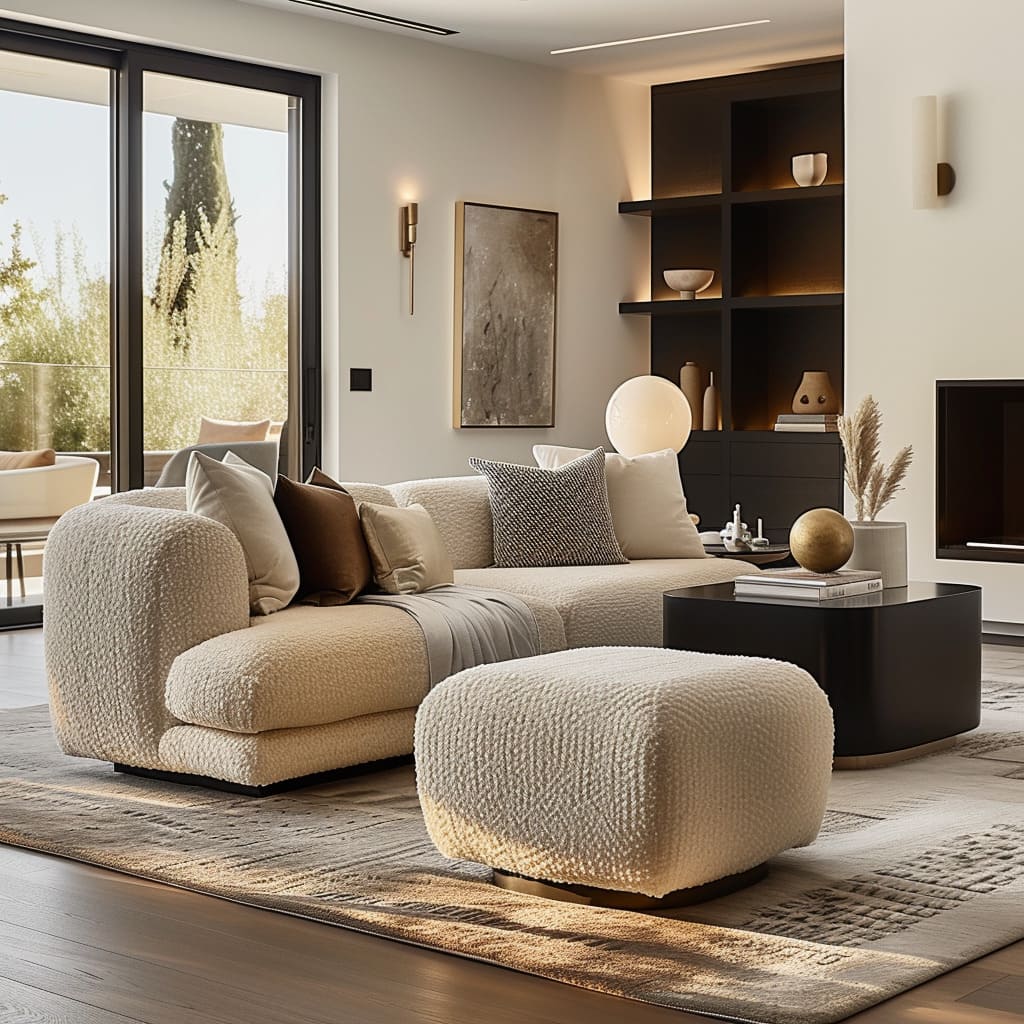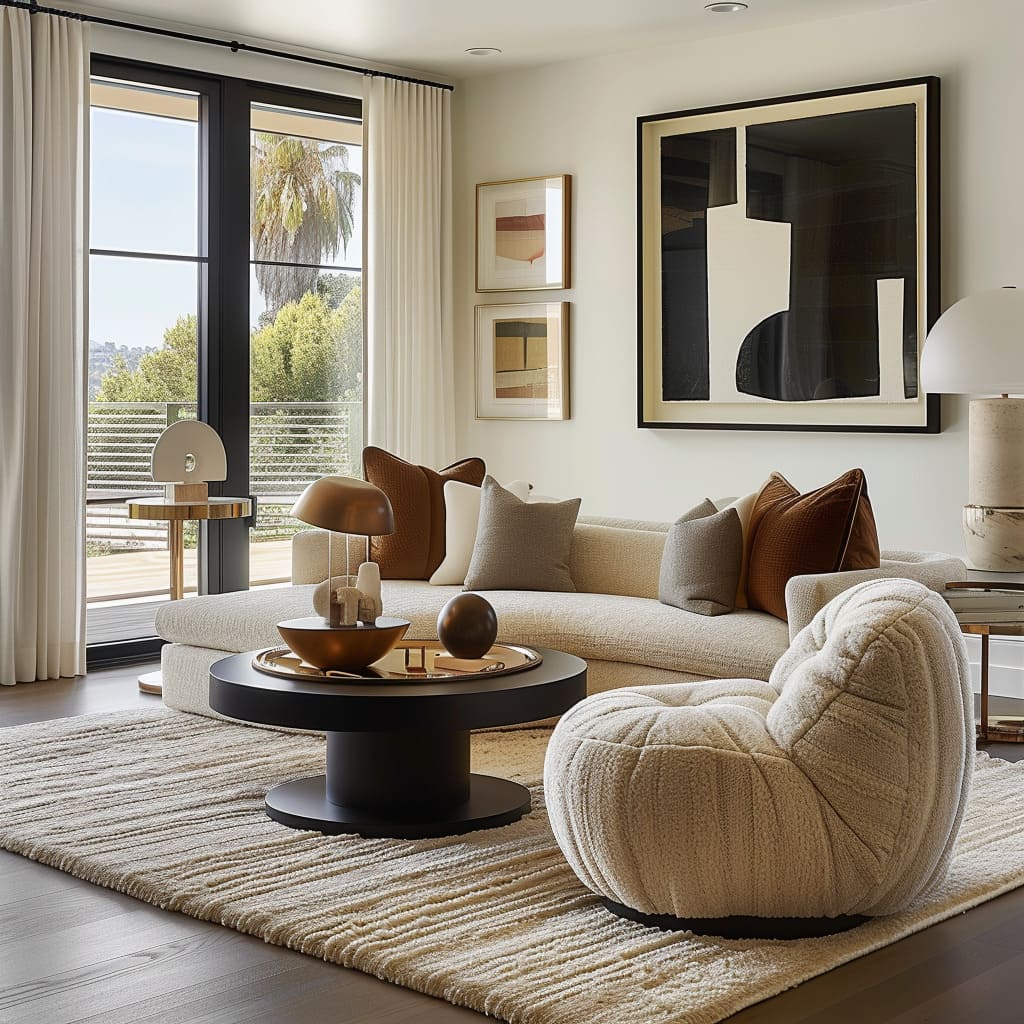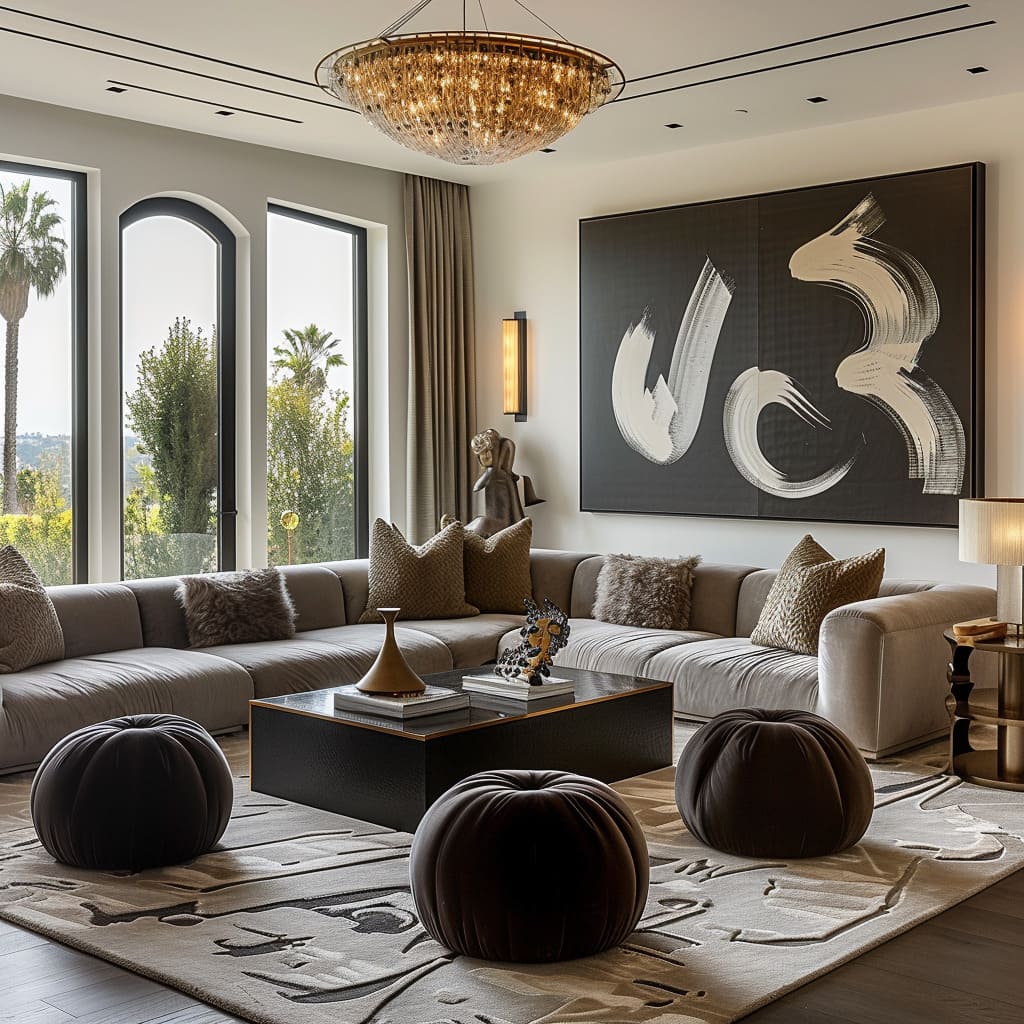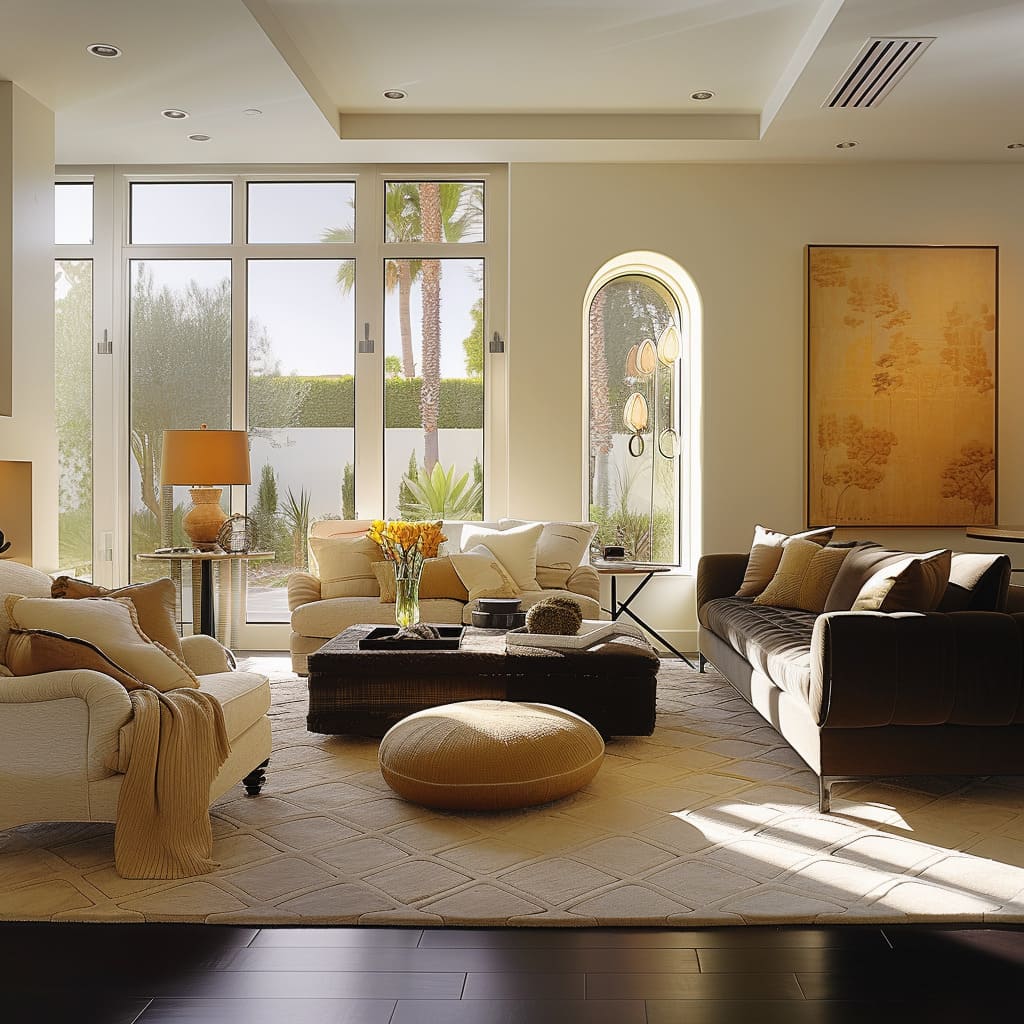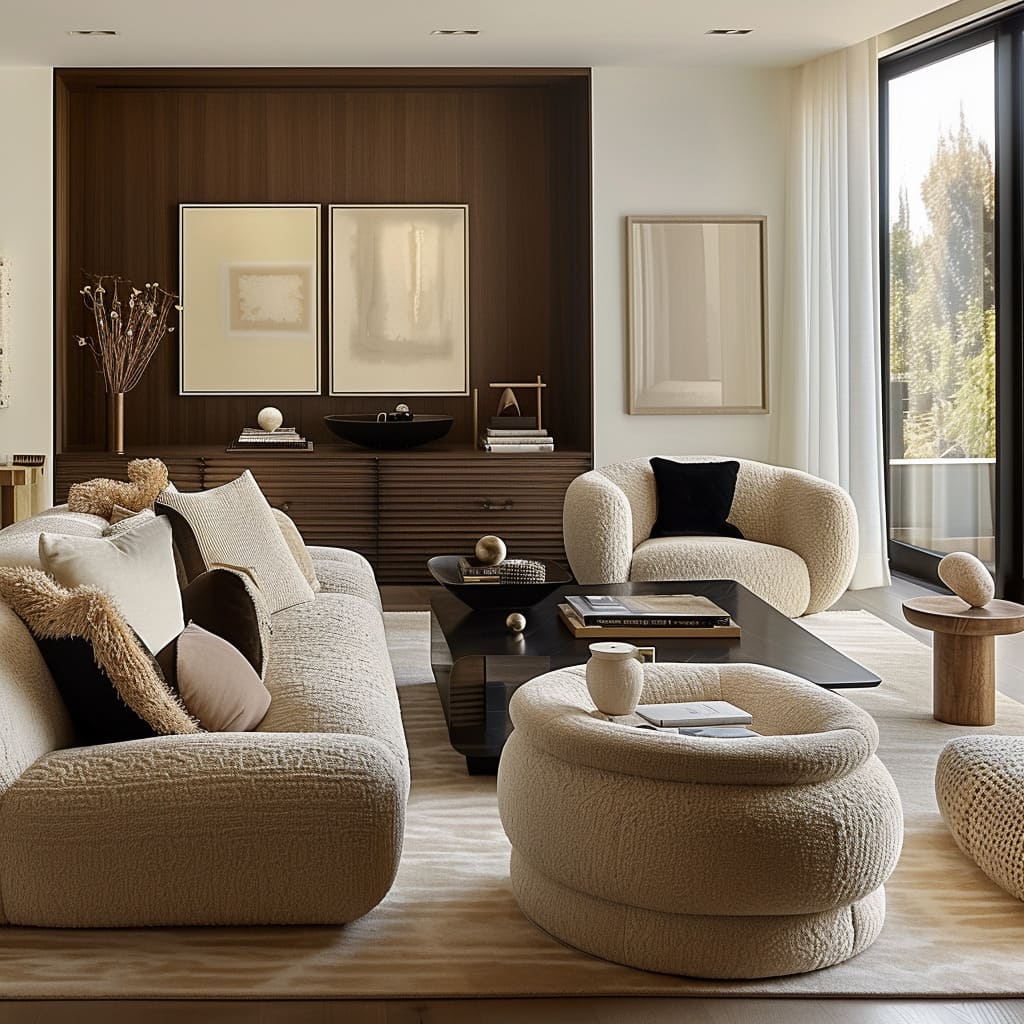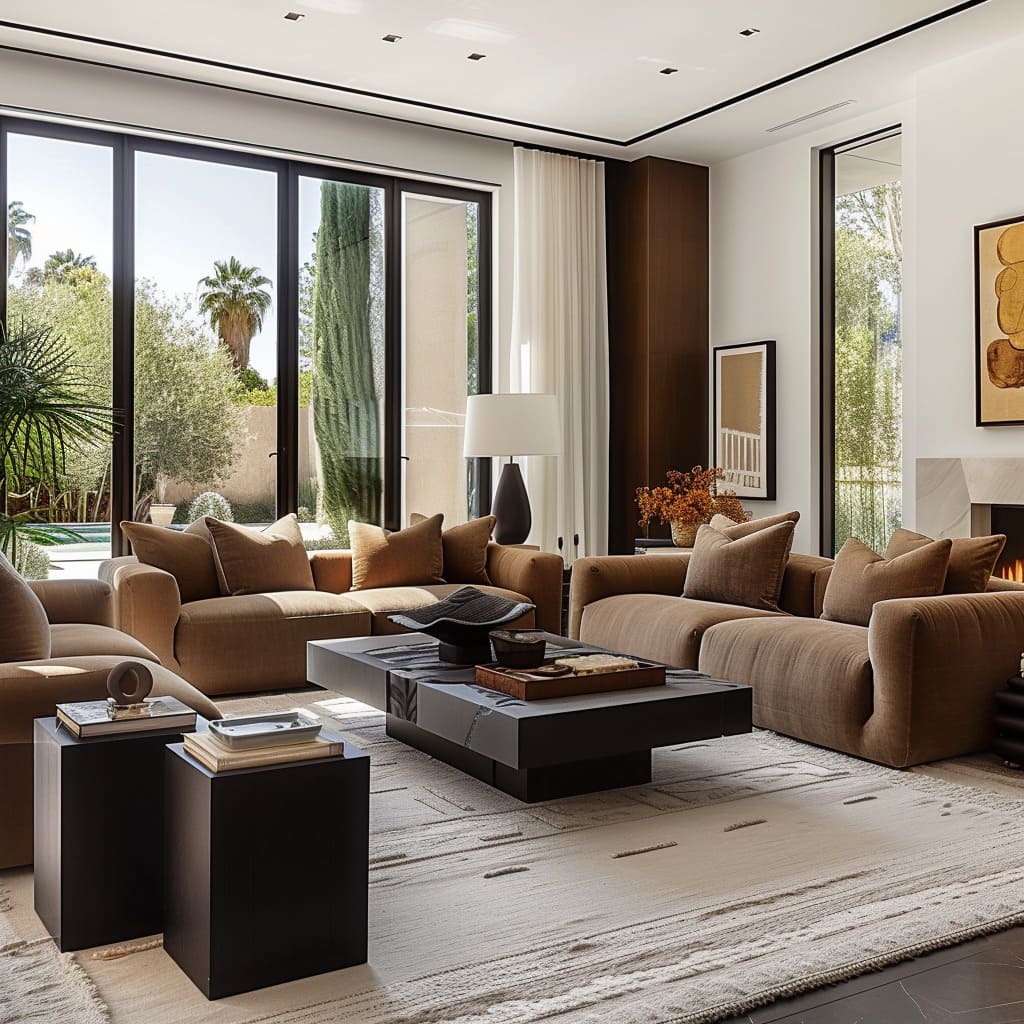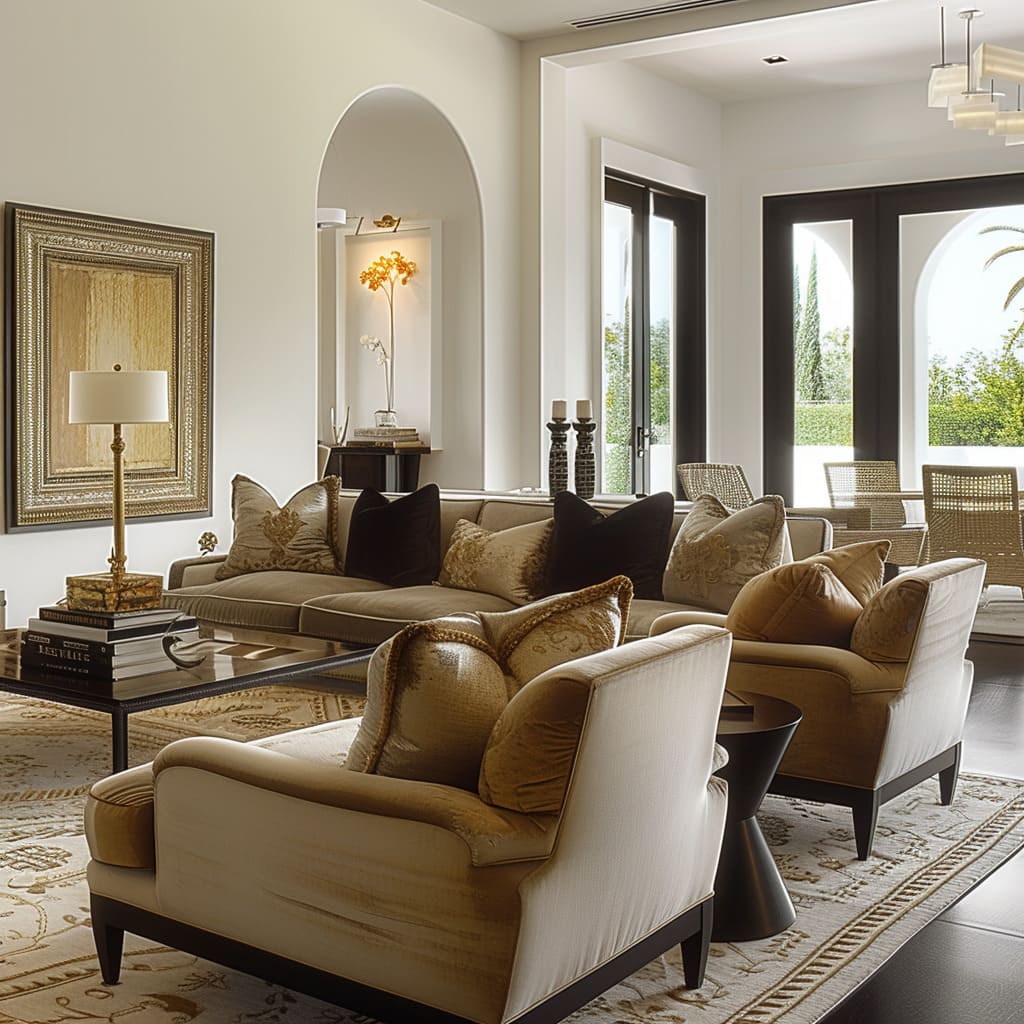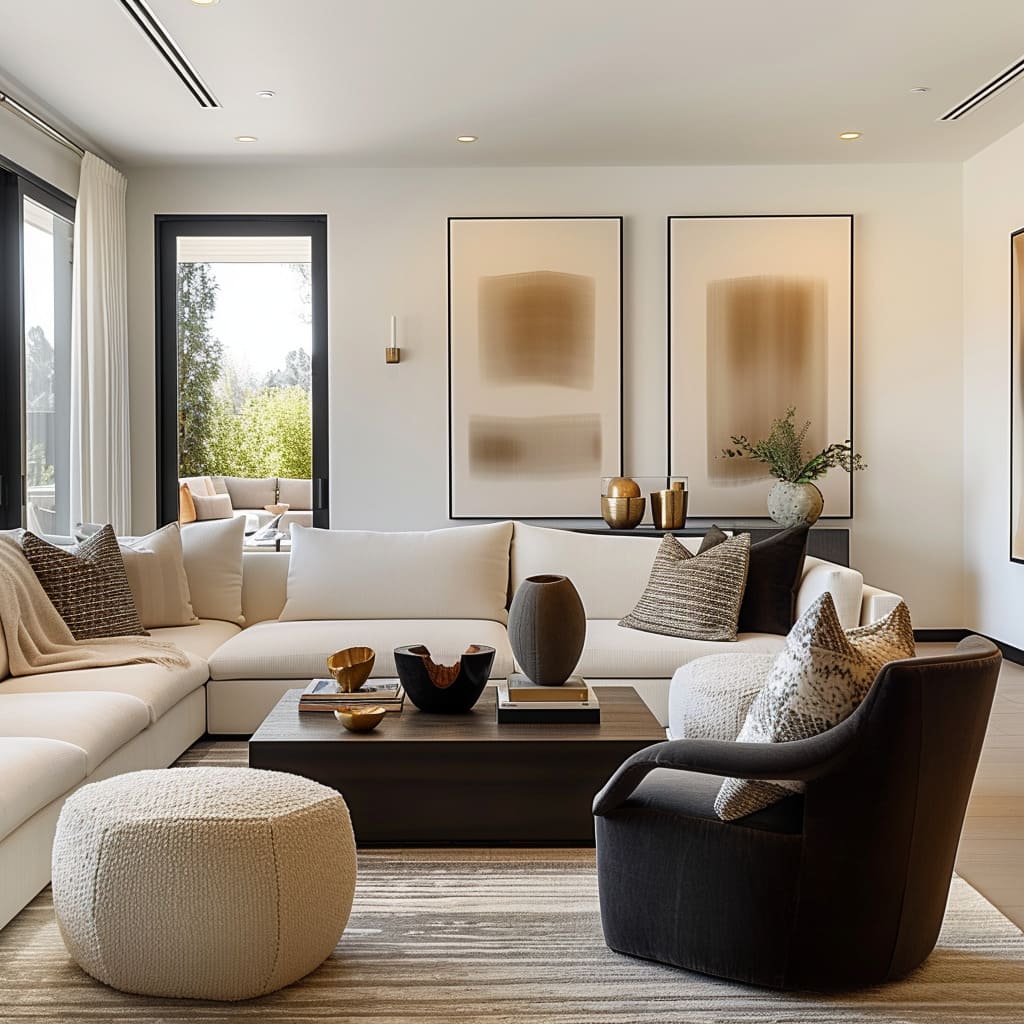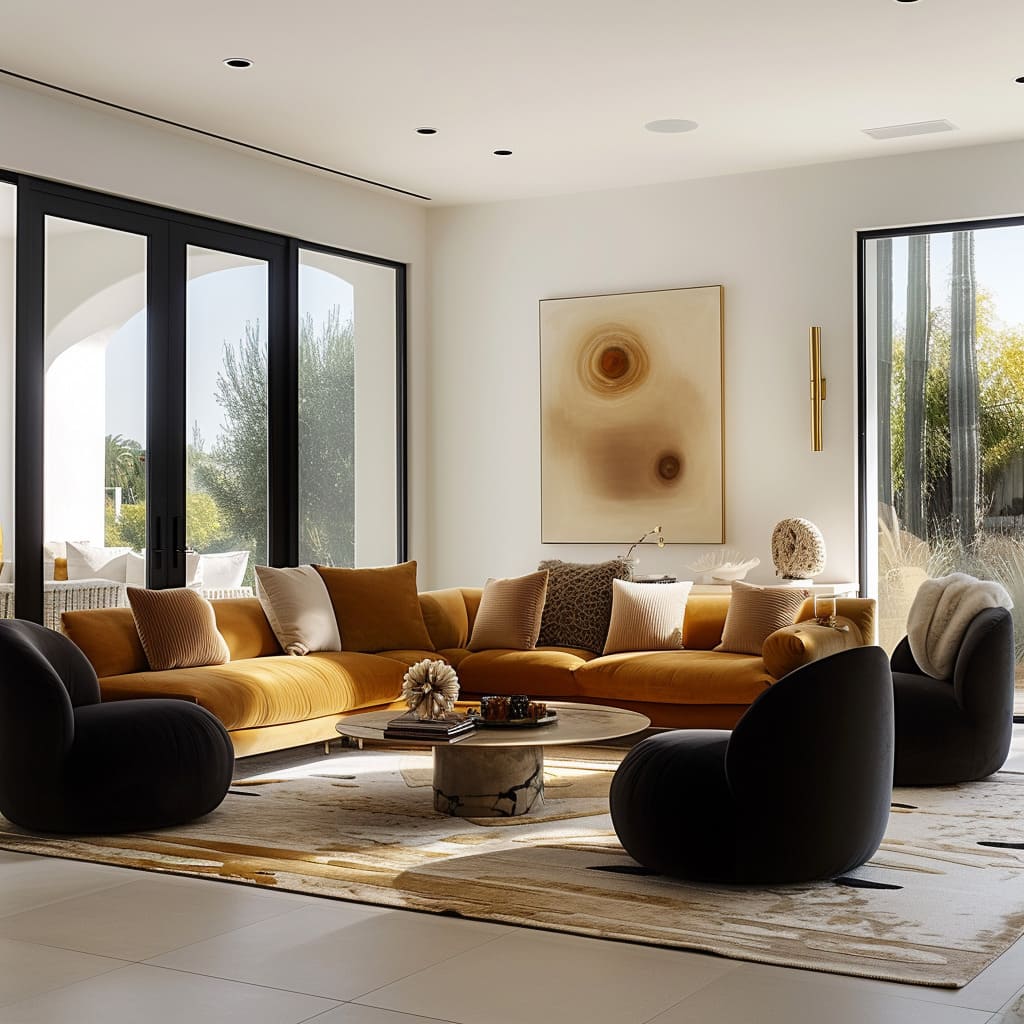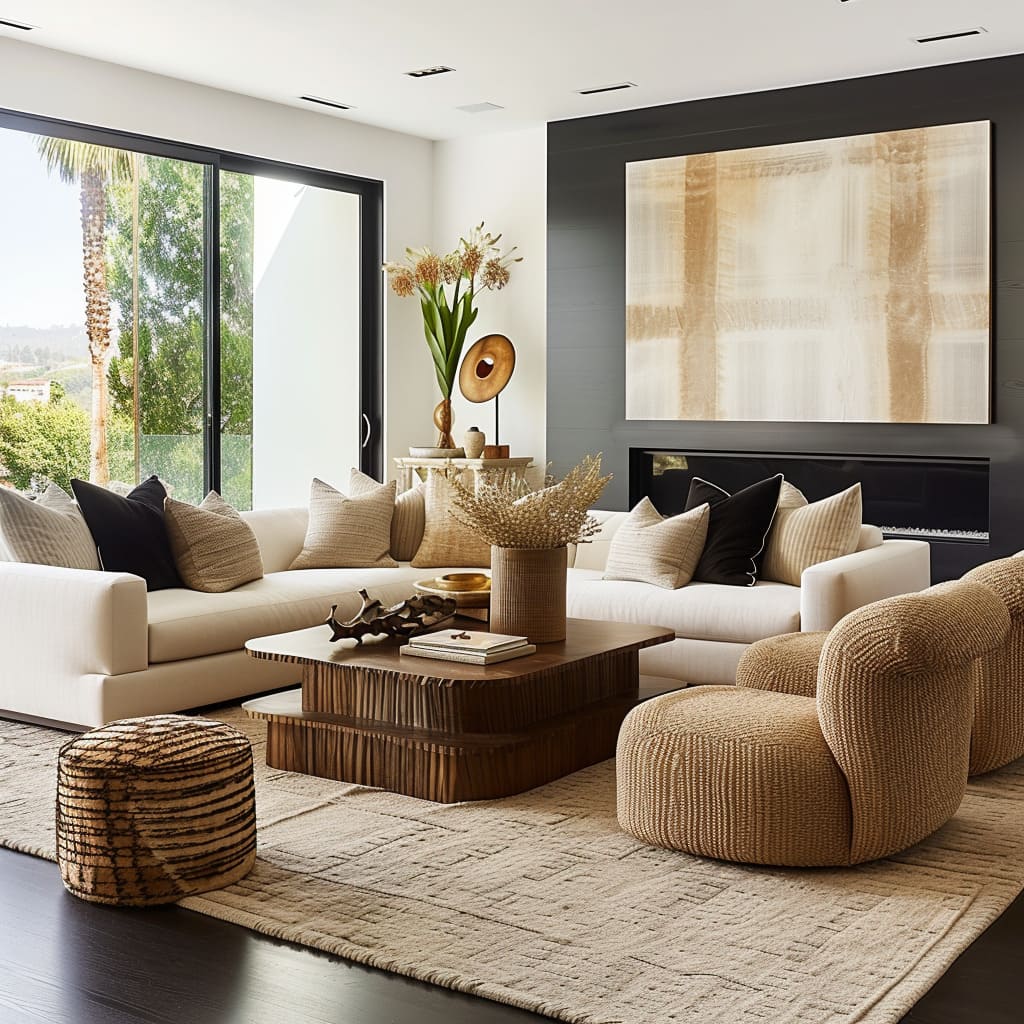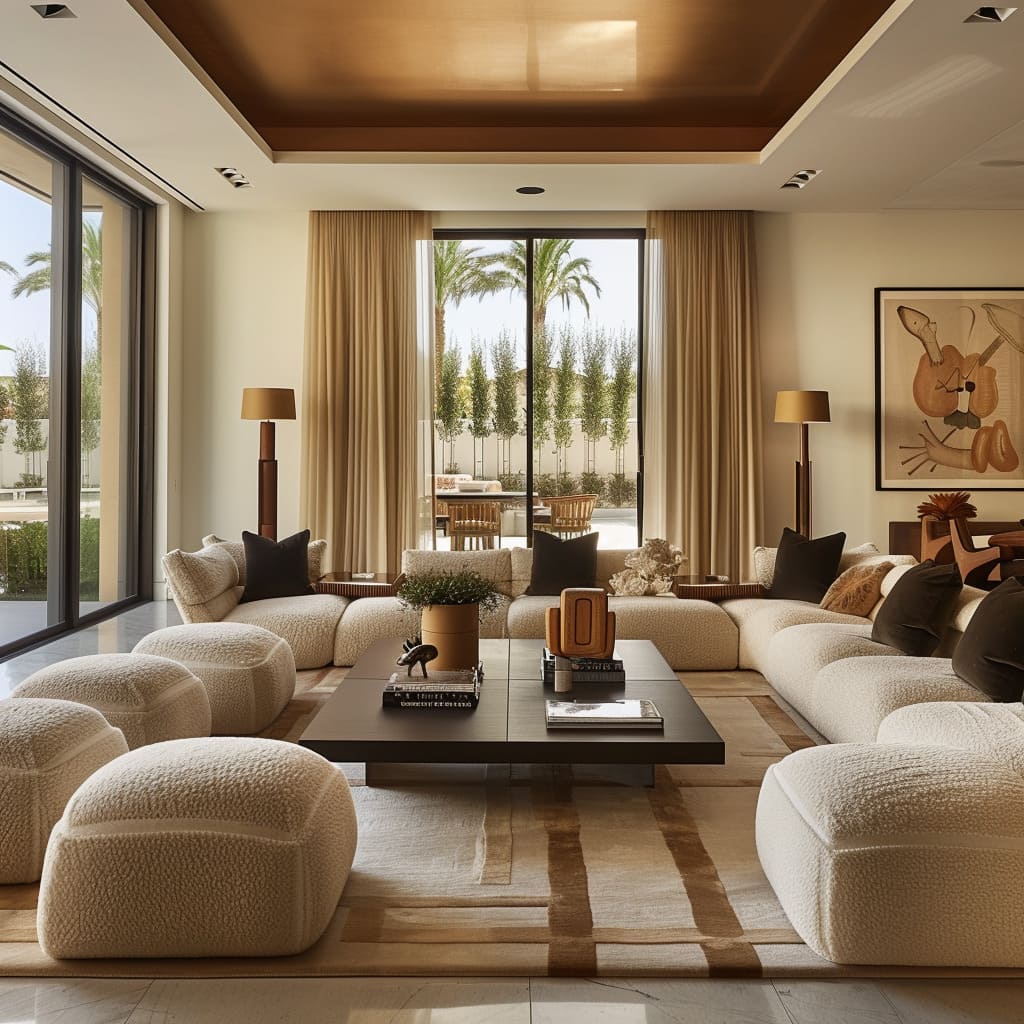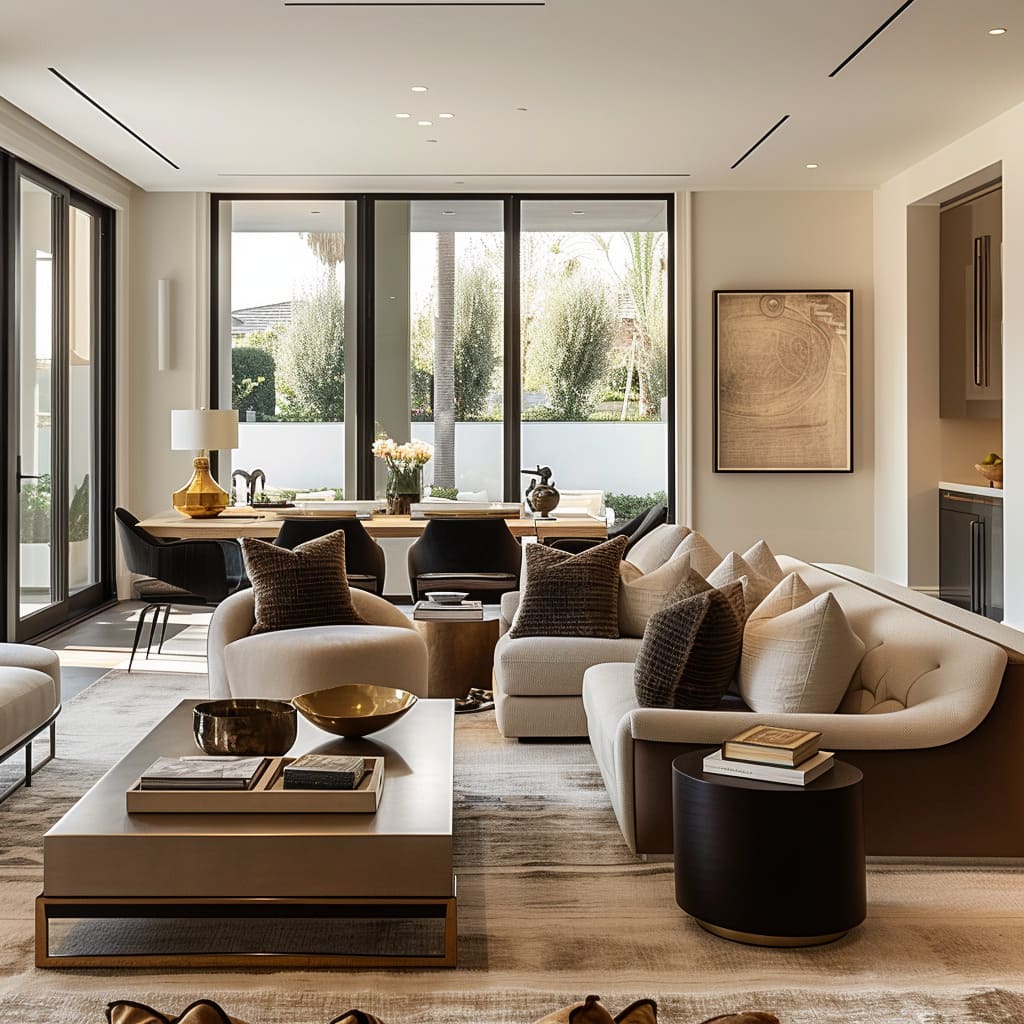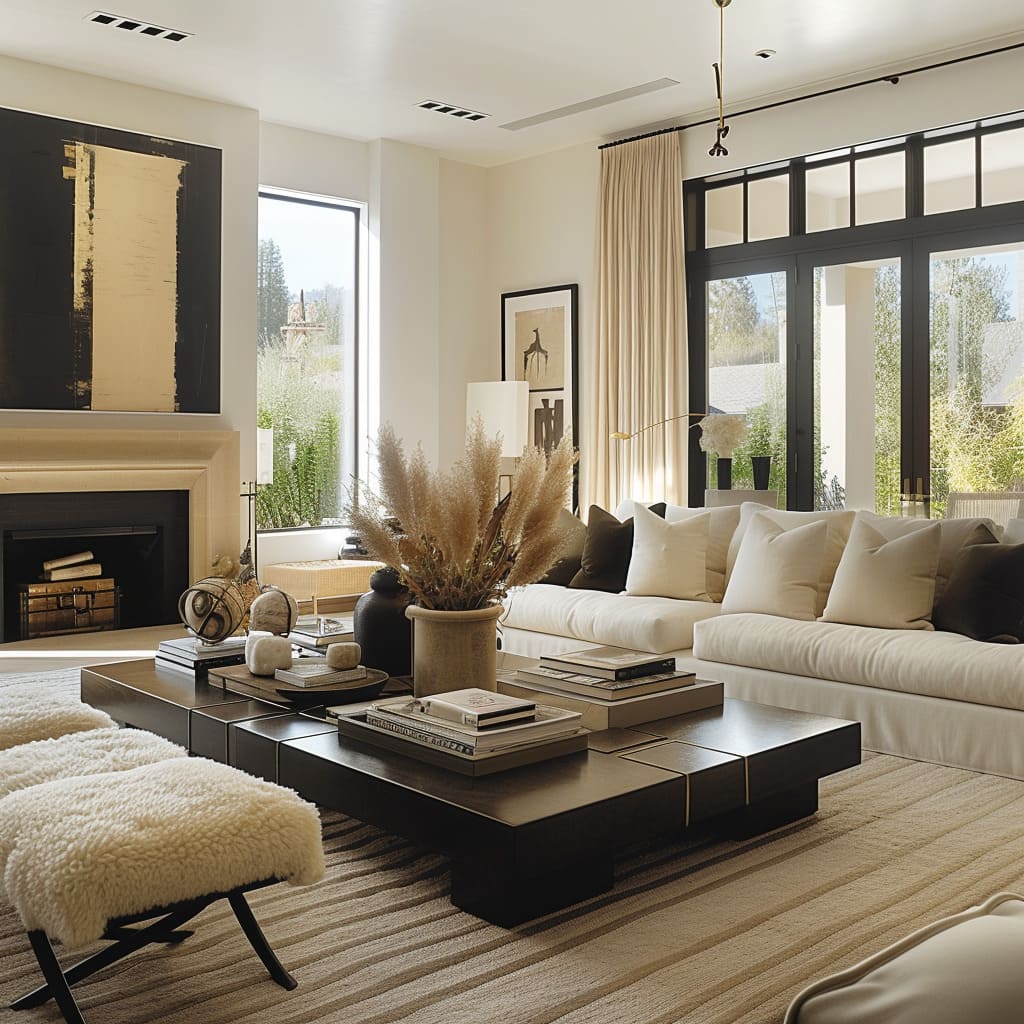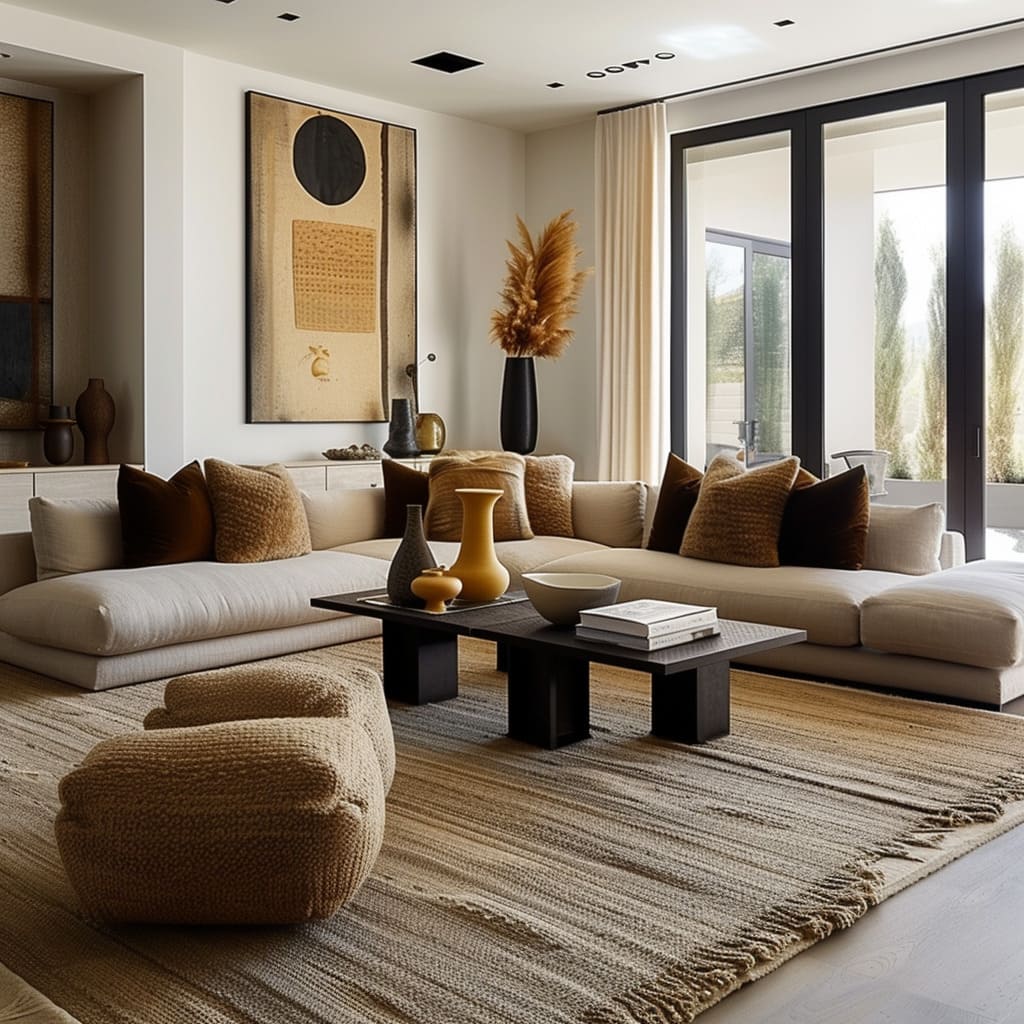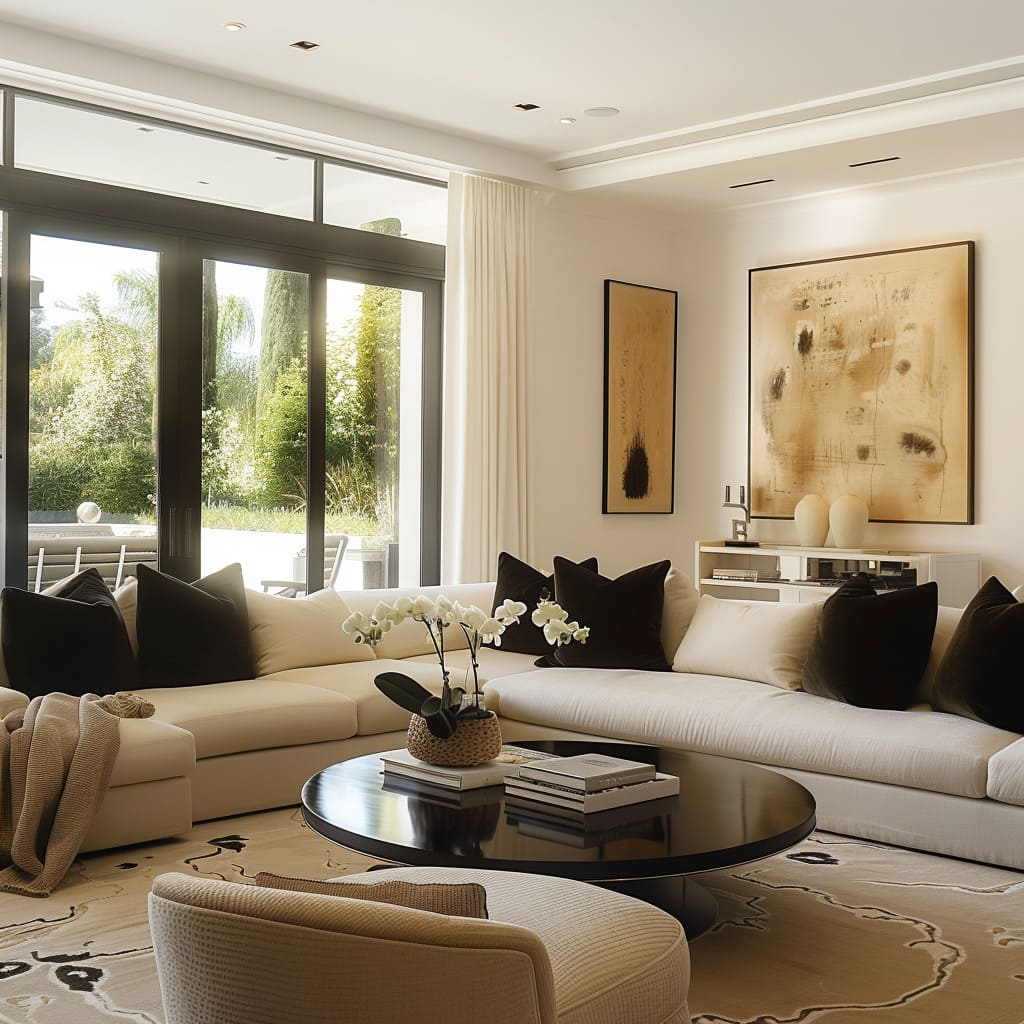In interior design, the tactile elements are as significant as the visual ones, if not more so. Textured fabrics bring a space to life, engaging the senses and adding a dimension of comfort and depth that transcends mere aesthetics.
This article delves into the transformative power of texture in home interiors, exploring how the interplay of different materials can enrich our living environments. From the sumptuous feel of a chenille sofa to the intricate weave of a handmade rug, textures shape our experience of a space, influencing not only our comfort but also our emotions and behaviors.
As we traverse through the modern and elegantly designed interiors, we will uncover how textures define the character of a room and how they can be effectively incorporated to create spaces that are as inviting as they are stylish.
<h3>Tactile Experience</h3> Textured fabrics not only beckon the sense of touch but also play a critical role in setting the emotional tone of a room. The tactile sensation of a bouclé chair’s intriguing nubs, or the inviting softness of a chenille sofa, engages us in a more intimate and comforting manner.
This interplay of texture stimulates our sensory experiences and can transform a static room into a dynamic space that encourages interaction and relaxation. We notice how different textures, from the smoothness of polished wood to the coarser feel of woven rugs, come together to create an inviting, multi-sensory environment.
The furniture pieces are not just to be admired from afar, but to be used, touched, and lived in, enhancing the user’s connection to the space. To incorporate this into your own home, focus on selecting furnishings and decor that offer a variety of textures and materials.
Layer throws, pillows, and rugs in contrasting fabrics to create a rich tapestry of touch that invites you and your guests to fully engage with the space.
<h3>Visual Depth</h3> Neutral color palettes, such as those dominating the interiors depicted, benefit immensely from the deliberate use of texture. It introduces a depth of field that might otherwise be absent in a monochromatic scheme.
The juxtaposition of light and shadow across various surfaces, such as a fluffy throw or a herringbone-upholstered armchair, creates a dynamic visual landscape within the room. This complexity is further enhanced by the natural light that filters through the windows, casting ever-changing patterns throughout the day, which breathes life into the space.
The strategic placement of lighting can accentuate these textures, drawing attention to the subtle interplay of surfaces and finishes. To achieve this visual depth in your own space, focus on incorporating a range of materials with different reflective qualities and texture densities.
Position lighting to highlight these elements and consider the time of day and the movement of light to ensure that the textures are revealed and celebrated, adding to the room’s overall ambiance.
<h3>Psychological Comfort</h3> The psychological impact of texture in an interior space is profound. As demonstrated , the interplay of soft fabrics and inviting upholstery creates an environment that feels intimate despite its spaciousness.
The tactile nature of bouclé chairs and tufted sofas brings an element of coziness, encouraging a sense of safety and shelter. The layering of pillows and throws adds to this effect, making grand living areas seem more personal and approachable.
This approach to design fosters a comforting ambiance where one naturally gravitates to unwind. To incorporate this feeling of psychological comfort into your space, focus on layering a variety of textures that invite touch and create visual warmth.
Choose furniture with fabric that begs to be touched, such as velvet or wool, and accessorize with cushions and throws in varying materials to create an inviting and nurturing space that beckons you to relax and feel at home.
<h3>Balance and Contrast</h3> In interior design, the interplay of textures and finishes is crucial for achieving a space that feels both cohesive and stimulating. The designs exemplify how balance and contrast are masterfully used, with plush fabrics set against the reflective sheen of polished metals and the deep luster of wooden surfaces.
The harmony achieved through this juxtaposition brings about a layered complexity that appeals to the senses and enhances the overall aesthetic. The matte finish of soft textiles provides a visual break from the hard, shiny surfaces, creating an engaging dialogue between the elements.
To bring this design strategy into your home, mix materials with different finishes. Combine smooth, high-gloss side tables with a sofa in a chunky weave, or pair a sleek leather ottoman with a nubby rug, to carve out a space that feels balanced and rich in contrast.
<h3>Visual Weight</h3> The visual weight of textured fabrics is a fundamental element in the design of a balanced interior space. These materials add a sense of gravity and presence to furniture, as observed where the textured upholstery of chairs and sofas serve as grounding elements in the rooms.
Rich boucle, nubby linens, and fluffy wools command attention and draw the eye, providing a counterpoint to the sleek lines of flooring and reflective surfaces. The tactile appeal of these fabrics encourages interaction and provides comfort, making them essential in creating living spaces that are both inviting and engaging.
To incorporate this principle into your own space, choose furnishings with substantial, touchable fabrics that contrast with the sleekness of your room’s hard surfaces. Place these heavier elements strategically to create focal points and to balance the visual flow of the room.
<h3>Acoustic Softening</h3> The strategic use of textured fabrics can transform a noisy room into a haven of peace. By absorbing excess sound, materials like thick woolen throws or deep-pile rugs can significantly reduce the echo and reverberation within a space.
The result is a more focused and serene environment conducive to relaxation or intimate conversations. The interiors show plush sofas and soft furnishings that contribute to this effect, dampening the sound and creating a cocoon-like atmosphere in a large and potentially echo-prone space.
In the featured living spaces, the use of large area rugs and upholstered furniture with generous padding not only enhances the auditory experience but also adds to the aesthetic and tactile appeal. Fabrics with a thick weave or raised texture, such as the bouclé on the chairs or the shaggy texture of the rugs, are particularly effective at sound absorption.
To achieve a similar acoustic softening in your own home, consider adding heavy curtains, upholstered wall panels, or large canvas artworks that can absorb sound. These elements will help to soften the acoustic profile of the room while also providing visual warmth and interest.
<h3>Psychological Comfort</h3> Textured fabrics play a critical role in creating a sense of psychological comfort within a home. The tactile quality of a material can evoke memories, emotions, and sensations that transform a space from merely functional to emotionally resonant.
The living rooms show spaces where the careful layering of textures—soft pillows, woven fabrics, and plush seating—create a welcoming ambiance that invites relaxation and a sense of well-being.
The selection of textures also follows a natural and neutral palette, which can further enhance the sense of calm and groundedness in a space. The gentle variance in fabric textures, from the smoothness of leather to the softness of wool, offers a sensory experience that can calm the mind and soothe the spirit.
To replicate this sense of psychological comfort, incorporate a variety of textures in your decor. Consider a mix of smooth silk, nubby linen, and soft velvet to provide a rich tapestry of touchable surfaces.
Arrange these textures in layers to create a landscape that is visually interesting and comforting to the touch.
<h3>Nature-Inspired Elements</h3> Textured fabrics often draw from the beauty and intricacy found in the natural world, reflecting patterns and surfaces that evoke the grainy texture of sand or the layered, organic lines of tree bark. This connection to the elements can introduce a serene and earthbound quality to any living space, fostering a tranquil environment that mirrors the harmony found outdoors.
In the curated interior designs, this principle is embraced through the choice of materials and decor. Plush, nubby textiles mimic the irregularities of stone surfaces, while the color palettes feature earthy neutrals and deep greens that recall the tones of a forest floor or a mossy bank.
The incorporation of natural wood grains, stone textures, and botanical motifs further enhances the feeling of being connected to nature, even from within the confines of a modern living space.
To integrate these nature-inspired elements into your own home, consider incorporating organic textures through upholstery, rugs, or throws. Select materials that not only look natural but also feel pleasant to the touch, such as wool, cotton, linen, or silk with a raw, unprocessed appearance.
Pair these with furniture that has natural wood finishes, or select decorative pieces that mimic natural forms, like a vase with a bark-like surface or a lamp base that resembles a smoothed pebble. Remember to balance these textures with smoother surfaces and clean lines to maintain a contemporary yet warm aesthetic.
<h3>Seasonal Adaptability</h3> Textured fabrics are not only visually appealing but also offer functional benefits, helping to regulate the temperature of a space. During the hot summer months, lighter weaves allow air to circulate, making a room feel breezy and cool.
Conversely, in the winter, denser, knitted textures can trap heat, providing a cozy and warm atmosphere. This adaptability is crucial as it means the living space can comfortably transition between seasons, contributing to the sustainability of the interior design by reducing the need for additional heating or cooling.
To achieve seasonal adaptability in your interior design, focus on layering. In summer, use lighter textiles like sheer linens or finely woven cottons to dress windows and furniture.
These fabrics can reduce glare while still allowing light and air to flow freely. When the weather cools, layer on thicker, textured throws and cushions in materials like wool or velvet to add warmth.
Consider also the color of your textiles; lighter shades can reflect sunlight and help keep a space cool, while darker, richer tones can absorb heat and add a sense of warmth. Rugs can be switched out seasonally as well—opt for jute or sisal in the summer and a thicker, plush pile rug for the winter.
<h3>Layering</h3> In the world of interior design, layering is a technique akin to creating a rich visual and tactile story within a space. It involves combining various materials to evoke depth, interest, and luxury.
For instance, a seating area might be adorned with a leather sofa, accented with plush velvet throw pillows and a soft wool blanket draped over the side. This practice of layering textures adds complexity and a sense of indulgence, encouraging the eye to travel and the hand to touch.
Each layer adds its own voice to the chorus, creating a symphony of tactile experiences that enrich the living environment.
When layering textures in your own space, consider starting with a foundational piece such as a sofa or an area rug, and build upon it. Think about complementary and contrasting textures that can coexist harmoniously.
Combine smooth leather with the plushness of faux fur, the warmth of wool, and the luxury of velvet. Keep in mind the balance and scale of textures to prevent a cluttered or overwhelming feel; the goal is to create an inviting and dynamic space.
<h3>Aesthetic Versatility</h3> Textured fabrics possess a chameleon-like quality that allows them to adapt to a variety of design aesthetics. For example, a rough, nubby linen can feel at home in a rustic setting yet appear utterly sophisticated when paired with sleek metal and glass in a modern design.
Textured fabrics serve as a bridge between different styles, bringing warmth to minimalist spaces and a refined edge to more traditional ones. This versatility means that an investment in quality, textured materials can endure through changing trends and tastes.
To capitalize on the aesthetic versatility of textured fabrics, select pieces that can transition across different styles. A knitted throw might complement the organic lines of a mid-century modern chair as well as it would the classic silhouette of a Chesterfield sofa.
Consider the scale and type of texture to match the aesthetic you’re aiming for—larger, bolder textures can make a statement in a contemporary space, while finer, more intricate textures blend seamlessly into traditional or vintage-inspired interiors.
<h3>Highlighting Architectural Features</h3> Textured window treatments or wall hangings are instrumental in emphasizing the unique architectural features of a space. They act as a frame, showcasing elements such as beautiful window frames, high ceilings, or intricate moldings.
By choosing materials with a rich texture that contrasts with the smoother surfaces of walls or floors, these features become more pronounced and celebrated within the space.
To utilize textures for highlighting architectural features in your interior, choose materials that draw the eye toward the desired area. Heavy drapes or woven blinds can accentuate tall windows, while a tapestry or quilted wall hanging can bring attention to the expanse of a wall.
The key is to let the texture stand out against more subdued backgrounds, allowing the architectural elements to take center stage. Remember to consider the interplay of light and shadow, as textures can cast intriguing patterns that further enhance the architectural beauty of your home.
<h3>Transitional Design Element</h3> Textured fabrics have a unique ability to unify diverse design elements within an interior space. They serve as a subtle yet powerful connector that bridges disparate materials and color palettes, facilitating a transition that feels both natural and designed.
This seamless integration is pivotal in achieving a balanced and harmonious aesthetic. The curated interior designs showcase this principle with textured upholstery that complements both the sleek surfaces of modern furniture and the organic forms of the surrounding architecture, creating a continuous visual flow.
To implement this transitional design element in your own space, you can select textured fabrics that resonate with both the color scheme and the materiality of the room. Consider a chunky knit throw that picks up the color of a statement wall, or tactile cushions that echo the finish of a contemporary metal side table.
The goal is to choose fabrics that will act as a bridge, providing a common thread that ties together the various elements of the room.
<h3>Sensory Variety</h3> Minimalist spaces often rely on a limited color palette and a restrained approach to design. In such environments, textured fabrics become the heroes of the sensory experience.
They introduce diversity and depth, engaging the senses without the need for bold patterns or colors that might disturb the minimalist ethos. The interiors displayed leverage this strategy, using richly textured fabrics to add a layer of complexity and comfort to the spaces, ensuring they feel inviting and lived-in.
To infuse sensory variety into a minimalist space, focus on the subtlety of textures. A shaggy rug, a bouclé chair, or linen draperies can add layers of touch and visual warmth.
Choose fabrics with a pronounced weave or raised pattern to create interest and invite touch, ensuring these elements are in a neutral color to maintain the minimalist palette.
<h3>Personalization</h3> Beyond color and pattern, textured fabrics offer a canvas for personal expression. They allow individuals to infuse their personality into their living spaces through tactile choices, which can be as distinctive and unique as their taste.
The interiors depicted echo this sentiment, with each space featuring textured elements that reflect a sense of individuality, from bouclé sofas to woven wall hangings, each adding a personal touch to the rooms.
To personalize your space with textured fabrics, select textures that resonate with your style and preferences. Whether it’s the rustic charm of burlap, the elegance of silk, or the casual comfort of cotton, let your choice of fabric textures speak to your personality.
Mix and match different textures to create a layered look that feels curated and reflective of your unique aesthetic.
<h3>Luxury and Opulence</h3> Textures that exude luxury, like the plushness of velvet or the sheen of silk, can transform a room from simple to sumptuous. These materials catch the light and create depth, adding layers of sophistication to any space.
They speak of affluence without uttering a word, creating an ambiance that is both lavish and inviting. The visual weight of such fabrics can serve as a focal point, drawing the eye and elevating the overall design aesthetic.
To infuse your space with luxury and opulence through texture, consider adding accent pieces like silk throw pillows or a velvet ottoman. These elements should complement the room’s color scheme while providing a contrast in texture to the surrounding materials.
Use them sparingly to create points of interest without overwhelming the senses.
<h3>Functionality</h3> The practicality of textured fabrics extends beyond their visual appeal, offering tangible benefits like enhanced durability and ease of maintenance—qualities particularly beneficial in high-traffic areas. Textured materials can withstand daily wear and tear better than their smoother counterparts, making them ideal for family-friendly living spaces or commercial environments that see a lot of use.
Choose fabrics with a tight weave or a protective finish for areas that will be used frequently. Consider materials like tweed or microfiber for upholstery—they are not only durable but also easy to clean, ensuring longevity and a consistent look over time.
<h3>Soft Transitions</h3> In an open-plan layout, textured fabrics can be instrumental in defining different areas without the need for walls or dividers. They create visual and tactile boundaries that gently guide the flow from one functional space to another, such as from a dining area to a lounging space, enabling each zone to feel distinct yet part of a cohesive whole.
Create these soft transitions by using area rugs with rich textures under furniture groupings to define sitting areas, or hang textured curtains to subtly separate a reading nook. The key is to ensure that these textures harmonize with the overall design language of the space, providing a sense of continuity.
<h3>Forgiving Surfaces</h3> Textured fabrics are the unsung heroes of practical interior design, offering the dual benefits of aesthetic appeal and low maintenance. Their varied surfaces are adept at camouflaging the occasional spill or scuff, keeping your living spaces looking immaculate for longer periods.
This makes them especially suited for homes with children, pets, or high levels of activity.
To take advantage of the forgiving nature of textured fabrics, select upholstery and textiles with a nubby or patterned surface for your most-used furniture pieces. Materials like bouclé, tweed, or patterned weaves are not only stylish but also excel at hiding everyday wear and tear.
Regular vacuuming and prompt spot cleaning can help maintain their pristine look without the need for frequent deep cleans.
<h3>Historical Reference</h3> Textured fabrics offer a unique opportunity to evoke the past and infuse a space with a sense of history and depth. The use of traditional materials like damask or intricately woven tapestries can bring the elegance and grandeur of bygone eras into a contemporary setting.
These classic textures provide a narrative that can be felt as well as seen, allowing the room to tell a story through its very surfaces.
To incorporate historical references in your interior design, consider using patterned fabrics that reflect the period you wish to evoke. A Victorian-style damask on a modern chair can serve as a nod to the past, while maintaining a foot firmly in the present.
Pair these with more contemporary pieces to create a dialogue between the old and the new.
<h3>Subtle Branding</h3> For the discerning eye, certain textures serve as an understated form of branding. Designer fabrics that boast distinctive textures, such as the quilted patterns of Chanel or the monogrammed motifs of Louis Vuitton, can act as quiet symbols of luxury and status.
These iconic textures signal a keen awareness of high-end design and sophistication.
In your own space, select pieces that subtly showcase their pedigree through their texture. A throw or a pillow fashioned from designer fabrics can add a layer of exclusivity and prestige without the need for overt branding.
<h3>Creation of Zones</h3> Textured rugs or throws are not just elements of decor; they are tools for structuring space. In larger rooms, these pieces can demarcate specific areas for dining, conversation, or relaxation, creating intimate zones within an open-plan environment.
The texture of these elements helps to visually and physically delineate these spaces, providing a sense of order and coziness.
Use a large, textured rug to anchor a seating area, or place a series of smaller rugs to outline individual zones within a room. Choose textures that contrast with the flooring to clearly define each area, while ensuring they complement the overall design scheme.
<h3>Enhancement of Furniture Silhouettes</h3> Texture can play a critical role in highlighting the form and design details of furniture. It can accentuate curves, underscore the geometry of a piece, and bring out details that might otherwise go unnoticed.
Through the interplay of light and shadow on their surfaces, textured fabrics can enhance the silhouette and presence of furniture, adding character and depth.
When selecting furniture for your home, look for pieces that combine interesting silhouettes with textured materials. A bouclé upholstered chair or a leather sofa with a tufted back can stand out, making a statement in the space.
Consider the placement of lighting to maximize the interplay of shadows and highlights on textured surfaces, which can further define the furniture’s contours.
Embracing texture within our living spaces is akin to adding layers to a story. Each fabric, each weave, brings its own narrative and emotional undertone to the interior landscape.
As we have seen through the various examples, texture is not merely a background player but a lead character in the design story. It offers a unique form of personal expression, historical reference, and functional benefit, all the while enhancing the sensory experience of a room.
From the strategic acoustic softening provided by plush textiles to the psychological comfort emanating from soft, enveloping materials, the thoughtful application of texture can craft spaces that are not only visually appealing but also emotionally resonant and physically comforting. By integrating a variety of textures into our homes, we create an environment that appeals to all senses, offering a retreat from the world that is as much a feast for the touch as it is for the eyes.
Whether through a luxury velvet throw or a rugged sisal rug, textures remind us that our homes are not just places to look at but to live in fully, comfortably, and with a sense of personal style.


